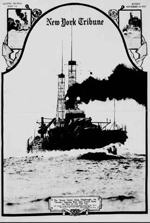 |
464k |
The Newest United States Dreadnought, the Nevada (BB-36) Speeding More Than Twenty Knots
An Hour on Her Trial Trip
The Nevada is the first United States Battleship to use oil as fuel. She is also the first to have a main battery of ten 14-inch rifles. | Image and text provided by Library of Congress, Washington, DC. & Oklahoma Historical Society.
Photo & text by New-York Tribune. (New York [N.Y.]) 1866-1924, 14 November 1915, GRAPHIC SECTION, Image 45, & The Beaver Herald. (Beaver, O.T. [Okla.]) 1895-1923, 24 February 1910, Image 3, courtesy of chroniclingamerica.loc.gov.
Insert U.S. Naval History and Heritage Command Photograph # NH 45796 via Robert Hurst.
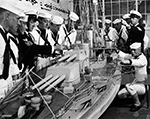 | 679k | As part of their training, a class of Naval Recruits at the United States Naval Training Station in Newport, Rhode Island, use a scale model of the type of ship they will be serving on to familiarize themselves with the its functions. Here the lecturer is discussing the position of the Conning Tower. | Photo by Hulton-Deutsch Collection/CORBIS/Corbis via Getty Images, courtesy of gettyimages.com.
|
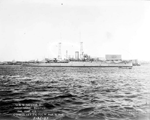 |
463k |
Starboard view of the Nevada (BB-36) off Boston Navy Yard on 23 March 1916. | Photo courtesy of Library of Congress, # LC-F82-1820 via Mike Green. |
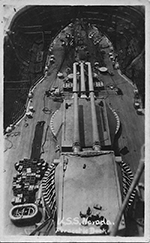 |
385k |
Forward turrets of the Nevada (BB-36), March 1916. |
Photo courtesy of Tommy Trampp. |
 | NR | WAKING UP AMERICA TO THE DANGER OF INVASION
Capt. W. S. Sims Shows How the Navy, as the First Line of Defence, Would Grapple With a Foe
CAPT. WILLIAM S. SIMS, U. S. N AND THE BATTLESHIP NEVADA (BB-36), OF WHICH HE IS IN COMMAND | Image and text provided by The New York Public Library, Astor, Lenox and Tilden Foundation.
Photo by The Sun. (New York [N.Y.]) 1833-1916, 30 April 1916, SIXTH SECTION SPECIAL FEATURE SUPPLEMENT, Image 55, courtesy of chroniclingamerica.loc.gov. |
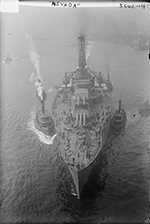 | 395k | The Nevada (BB-36) making her way down the river while being escorted by several tugs. | Digital ID: # ggbain-20195v, LC-B2-3642-14. Source: Library of Congress Prints and Photographs Division, from the George Grantham Bain Collection. |
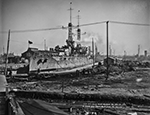 |
1.52k |
Two sides of Nevada (BB-36) at Navy Yard, Norfolk, Va. on 29 December 1916.
Note the tree on top of Turret A. |
Photo i.d. courtesy of Richard Jensen.
National Archives Identifier: 52557129 & (Insert-52557131)
Local Identifier: 181-V-1177 & (Insert-181-V-1178)
Photos courtesy of catalog.archives.gov & catalog.archives.gov |
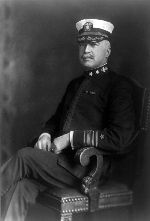 | 120k | Captain Joseph Strauss commanded the battleship Ohio (BB-12), in 1912; then became Chief of Bureau of ordnance 21 October 1913. Strauss assumed command of battleship Nevada (BB-36), 30 December 1916 and remained in command as the United States entered World War I.
Detached from the battleship in February 1918, he was designated Commander, Mine Force, Atlantic Fleet with the rank of Rear Admiral. He was awarded the Distinguished Service Medal both for directing the laying of the North Sea Mine Barrage and for the hazardous task of clearing it after peace came. In March 1921 he became Commander in Chief of the Asiatic Fleet with the rank of Admiral. | Digital ID: # cph 3b39649. Source: Library of Congress & submitted by Bill Gonyo.
|
Over There
1917 - 1919
|
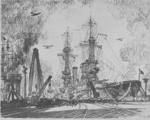
013617p | 3.96k | A Joseph Pennell Print showing what appears to be a Nevada (BB-36/37) class battleship in shipyard, 1917. | Image and text provided by loc.gov
|
 |
855k |
Nevada (BB-36) on the left & Florida (BB-30) on right at St. Helena training station, Norfolk, VA. receiving TLC.
Note the launch of the Rhode Island (BB-17) on the dock on left, dating the photo no earlier than March 1917 according to DANFS. | Photo i.d. courtesy of Richard Jensen.
National Archives Identifier: 45512685
Local Identifier:165-WW-334A-103.
Photo courtesy of catalog.archives.gov
|
 |
NR |
Among important changes in the navy made by President Wilson are the appointment of Captain W.S. Sims, commander of the battleship
Nevada (BB-36), to be president of the Naval College at Newport, and Rear Admiral A. M. Knight, who has been head of the college, to the command of the Asiatic fleet. | Image and text provided by University of Oregon Libraries; Eugene, OR.
Photo from the
East Oregonian E.O. (Pendleton, Umatilla Co., Or.) 1888-current, 24 January 1917, DAILY EVENING EDITION, Image 9, courtesy of chroniclingamerica.loc.gov. |
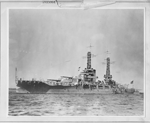 | 730k | Like her sister ship Oklahoma (BB-37) that appears in this photo, the Nevada (BB-36) is shown here circa 1917, while painted in an experimental camouflage pattern. | US National Archives photo # 80G-1035064 from NARA, College Park, Maryland, courtesy of Sean Hert. |
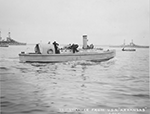 |
781k |
59 foot steamer of the Arkansas (BB-33).
The camouflaged Oklahoma (BB-37) & Nevada (BB-36) are to the left & right. |
Photo i.d. courtesy of Richard M. Jensen.
National Archives Identifier: 45512484
Local Identifier: 165-WW-334A-009.
Photo courtesy of catalog.archives.gov
|
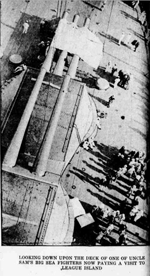 |
142k |
LOOKING DOWN UPON THE DECK OF ONE OF UNCLE SAM'S BIG SEA FIGHTERS NOW PAYING A VISIT TO LEAGUE ISLAND.
Either the Nevada (BB-36) or Oklahoma (BB-37). |
Image and text provided by Penn State University Libraries; University Park, PA.
Photo from the Evening Public Ledger. (Philadelphia [Pa.] 1914-1942, 03 February 1917, Night Extra, Image 16, courtesy of chroniclingamerica.loc.gov. |
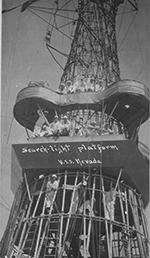 |
541k |
Searchlight Platform on the Nevada (BB-36), 1917-18. |
Photographer: Committee on Public Information.
National Archives Identifier: 45512418
Local Identifier: 165-WW-333D-3.
Photo courtesy of catalog.archives.gov & catalog.archives.gov
|  | 326k | Swimming call, Nevada (BB-36) 1917-18. | Photographer: Committee on Public Information.
National Archives Identifier: 45510156
Local Identifier: 165-WW-321D-041.
Photo courtesy of catalog.archives.gov
| 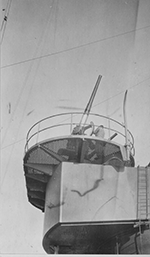 | 385k | Anti Aircraft gun mounted on fighting nest, Nevada (BB-36), circa 1917-18. | Photographer: Committee on Public Information.
National Archives Identifier: 45509984
Local Identifier: 165-WW-321C-4.
Photo courtesy of catalog.archives.gov |
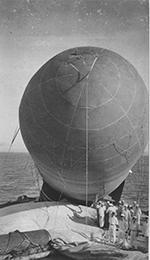 | 278k | The observation balloon onboard the Nevada (BB-36), 1917-18.
| Photographer: Committee on Public Information.
National Archives Identifier: 20807822
Local Identifier: 165-WW-63D-8.
Photo courtesy of catalog.archives.gov
| 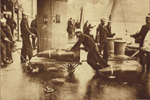 | 58k | "Armor piercing shells weighing half a ton or more apiece being loaded on an American Dreadnought that is preparing to sail for European waters." | Photo by Central News Photo Service.
Partial text from The War of the Nations (New York) N.Y. Times, 31 December 1919, courtesy of memory.loc.gov. |
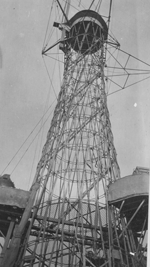
013688i | 849k | Looking up fighting mast of Nevada (BB-36), 1917-18. | National Archives Identifier:45512554
Local Identifier: 165-WW-334A-41.
Photo courtesy of catalog.archives.gov
| 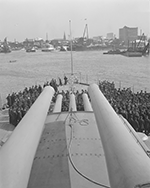 | 363k | Stern view of either Nevada (BB-36) or Oklahoma (BB-37) is shown here circa 1918 - 1920, in Boston harbor. | Photo 08_06_022798, courtesy of the Boston Public Library, Leslie Jones Collection, via digitalcommonwealth.org
| 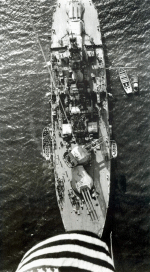 | 248k | In Queenstown Ireland, late August - November 1918. | Official USN photo now in the collections of the National Archives, courtesy of martimequest.com |
 | 85k | View of the boat deck area of the Nevada (BB-36), located between the two cage masts while the ship was in and around Queenstown, Ireland, 1918. Unlike the earlier Battleships which carried their boats and gigs suspended outboard, the boat deck was a better arrangement of space and utility.
This photo was taken by Burnell Poole, one of the best marine painters of the early 20th century. One of his paintings, "The 6th Battle Squadron of the Grand Fleet Leaving the Firth of Forth" was restored by the Naval Historical Center, Washington, D.C. | Courtesy of USNI. |
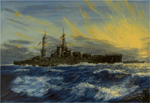 | 277k | The 1918 image of the Nevada (BB-36) escorting the Transport George Washington (ID-3018) to France with Pres. Wilson embarked for the Versailles Peace Conference in December 1918. | Painting courtesy of artbywayne.com. |
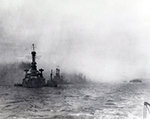 | 72k | Battleships of the Sixth Battle Squadron (anchored in column in the left half of the photograph): included the
Florida (BB-30)
Utah (BB-31)
Wyoming (BB-32)
Arkansas (BB-33)
New York (BB-34)
Texas (BB-35)
Nevada (BB-36)
Oklahoma (BB-37)
Pennsylvania (BB-38)
&
Arizona (BB-39)
at one time or another.
There are only three of the battleships present in this photo
at Brest, France, on 13 December 1918. George Washington (ID-3018), which had just carried President Woodrow Wilson from the United States to France, is in the right background.
Photographed by Zimmer | Naval History and Heritage Command # NH 63454. |
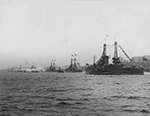 | 739k | OVERSEAS FLEET IN HUDSON RIVER
Right to left: Nevada (BB-36), Oklahoma (BB-37), Arizona (BB-39), New Mexico (BB-40) & Mississippi (BB-41). | Photographer: Paul Thompson
National Archives Identifier: 45513390
Local Identifier: 165-WW-337D-43.
Photo courtesy of catalog.archives.gov
| 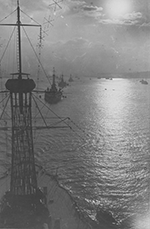 | 2.27k | SUNSET OVER THE VICTORY FLEET
The battleships of the U.S. Atlantic Squadron just back from its vigilant watch in the North Sea is here shown at rest in the Hudson River as the sun slowly sinks in the West. In the distance is the Oklahoma (BB-37), Nevada (BB-36), Utah (BB-31) & Pennsylvania (BB-38). | Photographer: Underwood & Underwood.
National Archives Identifier: 45513328
Local Identifier: 165-WW-337D-012.
Photo courtesy of catalog.archives.gov
| 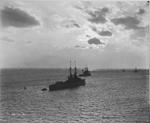
013062 | 2.00k | The sun sets on Atlantic fleet battleships of the Nevada class (BB-36/37), a Florida class (BB-30/31) followed by a Wyoming (BB-32/33) class battleship surrounded by lots of small boats in New York Harbor during the Naval Review of the Victory Fleet, December 1918. | National Archives Identifier:45513394
Local Identifier: 165-WW-337D-45.
Photo courtesy of catalog.archives.gov
| 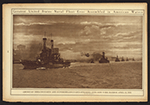 | 1.78k | "American dreadnoughts & super-dreadnoughts steaming into New York harbor 14 April 1919."
The Texas (BB-35) leads the procession with a airplane on her turret catapult. Note the escorting biplane.
The "escorting" aircraft is either a Curtiss HS-1 or HS-2 (note the single engine) can't tell which from the photo. The aircraft on a fly-off platform atop the No. 2 turret of the Texas is 1 of 6 Sopwith Camels purchased from Britain at the end of the war.
The platforms were a British concept designed to provide the fleet with an aircraft capable of reaching the high flying Zeppelins which the German Navy occasionally used as scouts. The Texas was the only US Battleship to be fitted with turret fly-off platforms while in Europe and was the test bed for this program in the US Navy. Not visible in this view is a stripped down (No fabric and no wings) Sopwith 1-1/2 Strutter lashed atop the No. 3 Turret. The platforms were eventually mounted on all 14" gun BB's through the New Mexico (BB-40 / 42) class (with mixed reviews from their commanders) and carried either a Hanriot HD-1 or a Nieuport' 28. Though equipped inflatable floats for water landings, this tended to do a lot of damage not the least of which was dowsing a hot engine in cold salt water. By 1920 a successful compressed air catapult was developed and were being mounted on the aft deck of all 4 turreted battleships and fly-off platforms were removed. The Texas and New York (BB-34), because of their 5 Turrets, lacked the deck space for the catapult and had to make do with a float plane (Vought VE-7) sitting on the aft deck which would be launched by lowering it over the side for a surface take-off.
If you look carefully at this photo you see the VE-7 on the deck and the A-frame hoist used for handling it. | Photo by Paul Thompson.
Text courtesy of N.Y. Times 31 December 1919, courtesy of memory.loc.gov.
Text i.d. courtesy of Chris Hoehn. |
 | 152k | Wintering at Guantanamo. The Atlantic Fleet is now "resting up" after patrolling the waters against German submarines.
The Nevada (BB-36), at Guantanamo Bay, Cuba, Spring 1919, with a "kite" balloon, used for over the horizon search and spotting, moored to her after deck. Note the seven 5 inch/51 recessed gun ports amidships and aft have their gun port shutters dropped. Also note the 5 inch/51 gun opening in stern that was later sealed over because of wet conditions. | USN photo.
Partial text from Naval History and Heritage Command photo # NH 45440 courtesy of Robert M. Cieri.
Partial text courtesy of The Evening Public Ledger, (Philadelphia [Pa.]) 1914-1942, 4 March 1919, Image 24, courtesy of chroniclingamerica.loc.gov. |
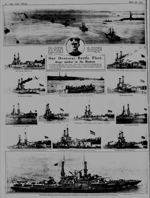 | NR | How the Atlantic Fleet looked to the camera man in a seaplane flying over lower Manhattan a week ago yesterday morning as the mighty armada came up the bay to anchorage in the Hudson off Riverside Drive for a two weeks' vacation after months of strenuous maneuvers in Southern waters. The destroyers Dale (DD-290) and Flusser (DD-289) are shown leading the column of eight dreadnoughts: Oklahoma (BB-37), Nevada (BB-36), Arizona (BB-39), flagship Pennsylvania (BB-38), Utah (BB-31), Florida (BB-30), North Dakota (BB-29) and Delaware (BB-28) past the Statue of Liberty at a fifteen-knot clip. In addition to the big battleships, the fleet includes thirty-two destroyers, numerous supply ships and several submarines.
The Atlantic battleship fleet is home again. Here are the twelve great first line fighting ships that are paying Father Knickerbocker a two weeks' visit. Over a hundred of Uncle Sam's grim sea warriors gray the North River, while their 30,000 sailor-men are given the freedom of the city in a royal welcome home.
The Battleship Mississippi (BB-41) leading the fleet into the harbor, as photographed from an airplane. Note the airplanes atop the forward and aft turrets.
| Image provided by: Library of Congress, Washington, DC.
Photo & text by New-York Tribune. (New York [N.Y.]) 1866-1924, 20 April 1919, Image 48, courtesy of chroniclingamerica.loc.gov. |
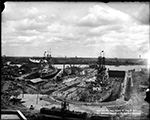 | 338k | U.S. Navy Yard, Norfolk, Va., 9 May 1919. Dry Dock No. 3 Nevada (BB-36) and Dry Dock No. 4 Wisconsin (BB-9). | National Archives Identifier: 52558687
Local Identifier: 181-V-2235.
Photo courtesy of catalog.archives.gov
|
 |
2.23k |
Four photo PDF of either the Nevada (BB-36) or Oklahoma (BB-37) at New York (Brooklyn) Navy Yard, New York City, New York. Sailors cleaning the hull of a battleship. |
Photo # Lot 5371-7 / 10
Photograph album donated by the heirs of Secretary of the Navy Josephus Daniels, courtesy of the National Museum of the U.S. Navy, via flickr.com. |

013619a | 370k | Nevada (BB-36) on active service, European Waters. |
Photo courtesy of digitalcommonwealth.org via Daniel Hacker. |
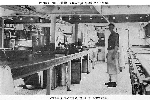 | 88k | Halftone reproduction of a photograph taken in the crew's galley on board the ship. It was published circa 1919 as one of ten images in a "Souvenir Folder" concerning Nevada. | Naval History and Heritage Command # NH 104610. Donation of Dr. Mark Kulikowski, 2007.
|
 | 72k | Halftone reproduction of a photograph taken in the ship's surgical operating room. It was published circa 1919 as one of ten images in a "Souvenir Folder" concerning Nevada. | Naval History and Heritage Command # NH 104612. Donation of Dr. Mark Kulikowski, 2007.
|
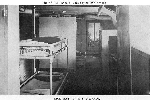 | 63k | Halftone reproduction of a photograph taken in the ship's sick bay. It was published circa 1919 as one of ten images in a "Souvenir Folder" concerning Nevada. | Naval History and Heritage Command # NH 104613. Donation of Dr. Mark Kulikowski, 2007.
|
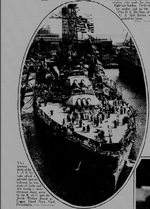 |
682k |
The spacious decks of the Nevada (BB-36) afford a splendid open air ballroom for hundreds of Jacks and Jill's during a recent afternoon dance given by the K. of C. and the Jewish Welfare Board at League Island Navy Yard, Philadelphia. | Image and text provided by Library of Congress, Washington, DC.
Photo from the New-York Tribune. (New York [N.Y.]) 1866-1924, New-York tribune. (New York [N.Y.]) 1866-1924, 31 August 1919, Image 48, courtesy of chroniclingamerica.loc.gov. |
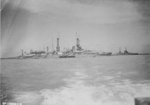
013912a | 618k | The fleet in Guantanamo Bay on 24 February 1919.
The Pennsylvania (BB-38) is the ship in the foreground, based on the pilothouse configuration. Nevada (BB-36) is beyond her forward, based on the mast platforms, and Arizona (BB-39) is beyond her aft based on mainmast location.
They were on or returning their way to Puerto Rico during the 1918 San Fermín earthquake.
| Photo i.d. & text courtesy of Photo by Sergt. McGarricle.
National Archives Identifier: 55238971
Local Identifier 111-SC-39928
Photo courtesy of catalog.archives.gov |
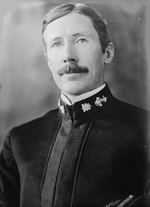 | 141k | Capt. William Dugald MacDougall was the Commanding Officer of the battleship Nevada (BB-36) from 23 October 1919 to 4 May 1920.
| Photo courtesy of the Library of Congress via Bill Gonyo. |
1920 - 1930
|
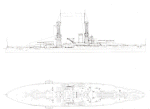 | 132k | Starboard and overhead view of the Nevada (BB-36) in 1920, line drawing by A. L. Raven. |
Photo and text courtesy of U.S. Battleships: An Illustrated Design History by Norman Friedman. |
 | 230k | Flags adorn the Nevada (BB-36) in this circa 1920 photo. | NHC / USN photo. |
 |
1.46k |
A painting by the artist Wayne Scarpaci entitled 'Into the Storm'.
This is my latest effort on the Battleship Nevada Centennial Project. It shows the Nevada (BB-36) in 1920 with sister ship Oklahoma (BB-37) and near sister Arizona (BB-39). Notice the 'Flying Off' platform atop turret 2. The platform folded out over the gun barrels and a wheeled aircraft would take off unassisted. The ship was unable to recover the plane so it would have to fly to a shore base to land. Starting in the mid-1920's compressed air launch catapults for float planes were added to all US battleships on their fantails. A light derrick type crane was added to the very stern to hoist the aircraft back aboard. In the the mid 1930's the compressed air catapult was replaced with a powder launch type (Which used a 5" powder charge). And a second catapult was added to the top of turret 3 and heavier crane added astern to handle the ever increasing weight of the aircraft carried. Early in WWII the catapult atop turret 3 was removed in all US battleships. In 1947 the USN cancelled the shipboard float plane program and removed the catapults from all ships. All three of the ships in this painting were sunk at Pearl Harbor and only Nevada was returned to service.
| Photo and text courtesy of artbywayne.com
| 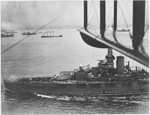
013631 | 3.39k | Nevada (BB-36) underway with aircraft-launching platform on turret, 1920.
The aircraft on the turret platform is an Hanriot HD-2. | Aircraft photo i.d. courtesy of Chris Hoehn.
National Archives Identifier:520583
National Archives # 80-CF-2045-1.
Photo courtesy of catalog.archives.gov
| 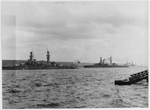
013927b | 4.34k | Lying off Riverside Drive, New York City, on 4 May 1920. Looking up river, the ships are: Pennsylvania (BB-38), Arizona (BB-39), Nevada (BB-36), and Oklahoma (BB-37). They are flying church pennants above the colors on the flagstaffs. | Photo NH 63340, courtesy of history.navy.mil
|
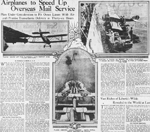 |
658k |
HOISTING A PLANE ON BOARD THE OKLAHOMA (BB-37).
IT WOULD BE EASIER FOR A LINER to PICK UP PLANES FROM THE PlER.
PLANE ABOARD NEVADA (BB-36).
NOTE SMALL SPACE REQUIRED FOR HOUSING |
Image and text provided by The New York Public Library, Astor, Lenox and Tilden Foundation.
Photo & text by The Sun and the New York Herald.(New York [N.Y.]) 1920-1920, 29 August 1920, Section 4 Sunday Magazine, Image 48, courtesy of chroniclingamerica.loc.gov. |
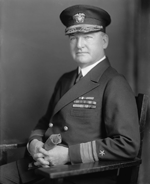 | 106k | Captain Luke McNamee was the commanding officer of the battleship Nevada (BB-36) from 1920 to 1921.
| Photo from the Library of Congress & via Bill Gonyo. |
 | 49k | "Combined Atlantic and Pacific Fleets in Panama Bay, 21st January. 1921". Right section (of three) of a panoramic photograph taken by M.C. Mayberry, of Mayberry and Smith, Shreveport, Louisiana.
Among the ships present in this image are (from left to right): Sicard (DD-346), Hatfield (DD-231), North Dakota (BB-29), Delaware (BB-28), Brazos (AO-4), Prometheus (AR-3), Utah (BB-31), Oklahoma (BB-37), Bridge (AF-1), Nevada (BB-36), Schenck (DD-159), Arizona (BB-39), Black Hawk (AD-9), Dickerson (DD-157), Dahlgren (DD-187), Herbert (DD-160), Columbia (CA-16), Cleveland (PG-33), Tacoma (PG-32), Semmes (DD-189) and one other destroyer.
| Photo # NH 86082-C, courtesy of Naval Historical Center. D.H. Criswell Collection. |
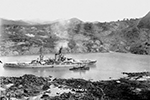 |
250k |
United States battleship Nevada (BB-36) passing through Culebra cut, Panama Canal.
This photograph, more than any other, brings out the remarkable engineering feat accomplished in making the dangerous cut. Men living in huts along the canal warn officials of approaching landslides. | Text from Evening Star. (Washington, D.C.) 1854-1972, 06 March 1921, Image 65, via chroniclingamerica.loc.gov.
Photo Donor: Margaret Fogg, Source Naval History and Heritage Command, Photo No. 2016.46 via Mike Green. |
 |
810k |
Nevada (BB-36), Oklahoma (BB-37) & possibly a Pennsylvania class battleship train their guns in 1921. |
Photo courtesy of Pieter Bakels.
| 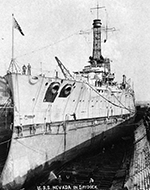 | 777k | Nevada (BB-36) in drydock. Photograph received 1921. | USN photo # 80-G-461423 from the National Museum of the U.S. Navy via flickr.com.
| 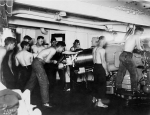 | 84k | Crewmen exercising with one of the ship's casemate 5"/51 guns, circa 1921. Taken by A.E. Wells, the Nevada's (BB-36) photographer. | Naval History and Heritage Command # NH 93414 from the collections of the Naval Historical Center. |
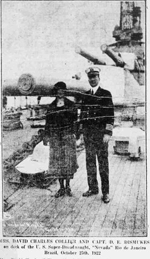
013608 | NR | Mrs David Charles Collier & Captain D.E. Dismukes on the deck of the Nevada (BB-36) in Rio De Janeiro, 25 October 1922. | Image and text provided by Mississippi Department of Archives and History.
Photo from the Macon Beacon. [volume] (Macon, Miss.) 1859-1995, 22 December 1922, Image 1, courtesy of chroniclingamerica.loc.gov.
|
 |
NR |
Brazilian exposition at Rio de Janeiro has Ameican battleship day celebration.
Two seafighters of the States fleet, Nevada (BB-36) and Maryland (BB-46), were in the harbor and the bluejackets formed a parade.
| Image and text provided by Library of Congress, Washington, DC.
Photo from the Evening Star. [volume] (Washington, D.C.) 1854-1972, 10 December 1922, Image 87, courtesy of chroniclingamerica.loc.gov.
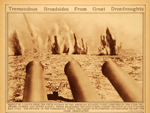 |
384k |
Circa 1922: "Result of a salvo from the Fifth Division of the American Atlantic fleet, composed of the Utah (BB-31), Delaware (BB-28), Florida (BB-30), and North Dakota (BB-29), which registered ten hits during target practice at Guantanamo Bay, Cuba. The Nevada (BB-36), in the foreground, towed the target to its position and remained nearby for close observation." |
Photo courtesy of Tommy Trampp.
 | 505k | Crews from the Nevada (BB-36) & New Mexico (BB-40) engage in boat races under oar power with Point Loma on the horizon during the early 1920's.
Of the many ships pictured, the Macdonough (DD-331) is in the upper right and the Williamson (DD-244) is in the upper left. The other destroyers remain unidentified. | From the collection of Benetta Buell. |
 | 188k | The Nevada (BB-36) at San Pedro, California, after her transfer to the Pacific Fleet. | USN photo courtesy of Robert M. Cieri. |
 |
2.13k |
The Nevada (BB-36) leads the battle force in the early 1920's.
The next ship in line is the Pennsylvania (BB-38). |
Photo i.d. & text courtesy of Richard Jensen.
Photo courtesy of Pieter Bakels. |
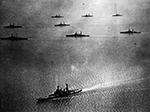 | 1.60k | U.S. Navy Battle fleet steaming into Panama Bay to join scouting fleet for combined fleet maneuvers, probably 1923.
The irony of this photo is that the ship with the least certain ID is the one closest to the camera! The probability is that she is the California (BB-44) based on the fact that the 3 Colorado class (BB-45 / 48) operated for such a short time without catapults and the ship in the photo has a bare quarterdeck). The photo is not clear enough to show twin or triple turrets. However, the ships in the background show enough unique characteristics to give more certainty about an ID. The nearest column are, left to right, Mississippi (BB-41) (uneven lookout station heights on the cagemasts), Tennessee (BB-43), (unique searchlight towers on after stack), and Idaho (BB-42) (lower bridge than New Mexico (BB-40)). The two ships in the second column are New York (BB-34) (bridge does not extend out far enough to be Texas (BB-35)) and Nevada (BB-36) (no enclosed lookout stations on the cagemasts and she has a catapult on her quarterdeck). The farthest column has (again left to right) Arizona (BB-39) (lower bridge), Pennsylvania (BB-38) (higher bridge) and New Mexico (again, the higher bridge). It is interesting that the only apparent catapult is the one on the Nevada. This would place the photo in the 1922-24 time frame. | Ernest La Rue Collection, Gift of the U.S. Army. Courtesy of the Library of Congress. USN photo # Lot-11952-VI-37, courtesy of the National Museum of the U.S. Navy, courtesy of flickr.com.
Photo & text i.d. courtesy of Richard M. Jensen.
|  | 819k | Panoramic photo of the U.S. fleet in Panama Bay (Pacific entrance to the Panama Canal) on 1 March 1923. 70 vessels are viewed; the Battle Fleet consists of all U.S. battleships from the Delaware (BB-28) through the Idaho (BB-42). | Source: Library of Congress Prints and Photographs Division, courtesy of Tom Kermen. Copyright R.G. Lewis, Y Photo Shop, Balboa, C.Z." |
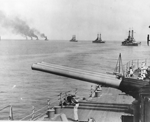 |
2.35k |
The Pennsylvania (BB-38) follows other battleships during maneuvers. The first three ships in the background are Nevada (BB-36), Oklahoma (BB-37), and Arizona (BB-39) in that order. However, the photo pre-dates the 1925 Australia / New Zealand tour since Oklahoma lacks the enlarged lookout stations on the cagemasts. |
Photo i.d. & text courtesy of Richard Jensen.
Photo courtesy of Pieter Bakels. |
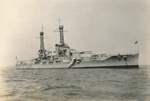 | 892k | The E is the 2nd letter in Nevada (BB-36). | Photo from Charles T. Wilder collection courtesy of David Way.
| 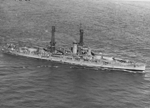 | 820k | The 3rd of March 1924 found the Nevada (BB-36) most likely off San Pedro. | Photo i.d. courtesy of Chris Hoehn.
US National Archives photo # 80G-1038255 from NARA, College Park, Maryland, courtesy of Sean Hert. |
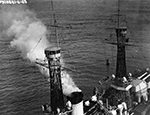 | 1.58k | Nevada (BB-36) fighting top of battleship, note movie operator's in foretop, 27 June 1925. | USN photo # 80-CF-14-2045-5 from the National Museum of the U.S. Navy via flickr.com. |
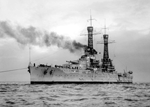 |
448k |
Nevada (BB-36) visited Melbourne together with the fleet flagship Seattle (ACR-11).
The 1925 visit was the largest fleet visit of warships at one time to either NZ and Australia, and was prompted by US irritation at the visit of HMS Hood and HMS Repulse to the Pacific including Pearl Harbor in 1924. |
Photo & text courtesy of Allan Greene via Chris Howell. |
 | 171k | Sea Bag Inspection, 1925. Another battleship is seen astern of the Nevada (BB-36). | USN photo courtesy of Robert M. Cieri. |
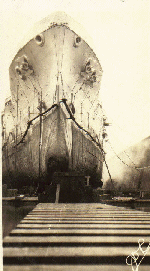 | 97k | Nevada (BB-36) in drydock in 1925. | USN photo courtesy of Robert M. Cieri. |
 | 379k | Photo of the Nevada's (BB-36) 2nd Division in Port Angeles, Washington in July on 1926 and was taken by J.O. Reynolds, Ship's Photographer. The contributor's Great Uncle, ENS William P. Tammany is in the front row, 13th from left. ENS Tammany was a 1924 graduate of the Naval Academy.
| Photo courtesy of Curtis Tammany. |
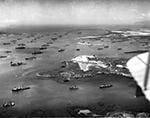 |
NR |
Ships of the U.S. Fleet pictured at anchor at Guantanamo Bay, Cuba, during winter exercises in 1927.
The "center" row has Mississippi (BB-41) then Langley (CV-1) , Oklahoma (BB-37), Pennsylvania (BB-38) and Arizona (BB-39) in that order. The next row to the left has Idaho (BB-42) then New Mexico (BB-40), followed by 3 of the Tennessee/Colorado class (hard to pick out distinguishing features in this photo), with Nevada (BB-36) as tail-end-Charlie. Further to the left are another Tennessee/Colorado class BB and a Memphis (formerly Tennessee) class armored cruiser. Two unidentified Omaha class cruisers are in the foreground. There are at least 17 destroyers, identifiable (bottom, right) is Mahan (DD-102), converted to a minelayer and redesignated DM-7, but still wearing her old DD hull number (102) and two submarine tenders in the foreground with about 10 smaller and two large submarines. The peninsula in the right foreground is South Toro Cay, where the drydock is still visible that was begun in 1904, but cancelled two years later.
|
Photo i.d. courtesy of Richard Jensen & wikipedia.org.
Photo courtesy of wikipedia.org via Branden Deschaine & Fabio Pena.
| 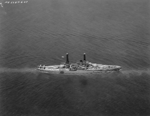 | 2.93k | Nevada (BB-36) taken off Hampton Roads on 4 June 1927. | Photo courtesy of wikimedia.org via Alexey Sokolov. |
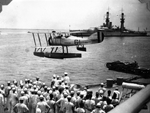 | 496k | A Vought UO-1 (A-6613) is launched from Nevada (BB-36) circa 1927-29. | This image is from a photo album donated to the Museum by JL Highfill, who was a photographer for the Navy before and during the Second World War. Image courtesy of San Diego Air and Space Museum Archive. Piction ID:38278595 - Catalog:AL-135A 198 via Robert Hurst. |
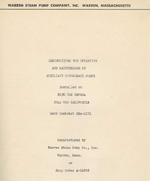 | 2.44k | Instructions For Operation & Maintenance of Auxiliary Condensate Pumps for the Nevada (BB-36) & California (BB-44). | Photo fix courtesy of Tom Kermen.
Photo courtesy of Ed Zajkowski. |
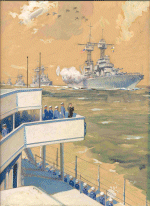 | 122k | Watercolor of a Presidential review during President Hoover's term of office, 1928-32.
Crews line the rails of a Colorado class (BB-45 / 48) battleship as the ships pass in line astern of the reviewing stand with the airship Los Angeles (ZR-3) piercing the clouds accompanied by 9 biplanes. | Courtesy of Michael Schwarz.
|
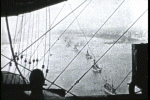 | 56k | View of the U.S. Battlefleet from above, possibly from the airship Los Angeles (ZR-3). | Photo courtesy of periscopefilm.com. |
 | 350k | Nevada (BB-36) being modernized at Norfolk Naval Shipyard between 4 May 1929 and January 1930.
The date has to be from this period of time because the Arizona (BB-39) entered Norfolk on 4 May 1929 to prepare for modernization.
Placed in reduced commission on 15 July 1929, Arizona remained in yard hands for the next 20 months; tripod masts, surmounted by three-tiered fire control tops, replaced the old cage masts; 5-inch, 25-caliber antiaircraft guns replaced the 3-inch 50s with which she had been equipped. She also received additional armor to protect her vitals from the fall of shot and blisters to protect her from torpedo or near-miss damage from bombs. In addition, she received new boilers as well as new main and cruising turbines. Ultimately, she was placed in full commission on 1 March 1931.
The Auxiliary to the left of the Arizona is 1 of 8 Patoka class fleet oilers, most likely either Sapelo (AO-11) or Salinas (AO-19).
| USN photograph courtesy of Ric Hedman.
Partial text courtesy of DANFS.
Photo i.d. contributed by Chris Hoehn, Jeff J., Chuck Haberlein & Mike Green. |
 | 50k | Nevada (BB-36) in the background & Arizona (BB-39) in the foreground being modernized at Norfolk Naval Shipyard between 4 May 1929 and January 1930. | USN photo from nnsy1.navy.mil contributed by Mike Green. |
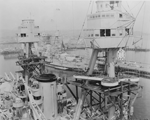
013708 |
981k |
Under refit at the Puget Sound Navy Yard, Bremerton, Washington, on 28 April 1931. Note .50 cal. AAMG platforms being fitted to tripod masts, fire control tops, range clock, searchlight platform on stack, and Nevada (BB-36) in background. |
Naval History and Heritage Command photo NH-93502 courtesy of .history.navy.mil |
 |
499k |
Nevada (BB-36) on fleet maneuvers area of Guantanamo Bay, Cuba; viewed by a plane from the Saratoga (CV-3) on 24 March 1930. |
USN photo # 80-G-651426, from NARA, College Park, Maryland, courtesy of Sean Hert.
| 1931 - Pre Pearl Harbor Attack
|
 | 1.07k | The Nevada (BB-36) at a California port sometime after 1930.
Following the 1925 refit the New York class (BB-34/35) battleships profile sported the standard tiered fire control tower atop a tripod mast almost identical to that of the Nevada. Further aft would be the now single funnel followed by the shortened after fire control tower sitting atop the O1 deck and below the top of the funnel. The Main mast is still a tripod and is located between the No. 3 and No. 4 turrets. And lastly the New York class (BB-34/35) were flush decked vessels.
The vessel in the background of the photo clearly sports two widely spaced funnels, the after one is issuing a plume of smoke and has a pole mast for its main mast which if it were situated on a New York class (BB-34/35) would stand somewhere in the vicinity of the No. 4 Turret. And despite the water spot a close examination of the bow will show what looks like a clipper bow. The bow and the pronounced step of the weather deck aft of the forward funnel suggest that this is an American heavy cruiser probably of the Portland class. | USN photo courtesy of Robert M. Cieri.
Photo i.d. by Chris Hoehn, Jeff J. & Chuck Haberlein. |
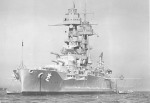 |
58k |
Excellent circa 1930's image showing details, Long Beach Ca.
This photo was originally thought to be the Oklahoma (BB-37), but was subsequently identified as the Nevada (BB-36) because of the number of platforms on the forward mast under the control top; (prior to receiving the cloverleaf platforms the Oklahoma only had one platform, Nevada had two). Also, the shape of the boat cranes across the top is a clear indicator of which ship you are looking at.
The Nevada crane main beam was straight across from the post with a supporting arm angling up to the main beam. The Oklahoma main beam had the supporting brace connecting from the top of the post to the main beam.
|
Photo courtesy of Paul Ayers & copy The Inman Co. Long Beach CA.
Photo & text I.d. courtesy of Jeff J., Chuck Haberlein & Mike Green. |
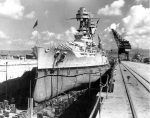 | 111k | In Dry Dock Number 1 at the Pearl Harbor Navy Yard, Hawaii, 6 March 1932. The Nevada (BB-36) in drydock for inspection and cleaning at Pearl. She is the first battleship to use the dock since it was completed in 1919. Note men painting her boot topping from stages rigged over the side, and outline of her anti-torpedo "blister" where it merges with her forward hull. | Naval History and Heritage Command # NH 50102 from the collections of the Naval Historical Center.
Image and text provided by Library of Congress, Washington, DC.
Photo from Evening Star.[volume] (Washington, D.C.) 1854-1972, 6 March 1932, Image 96,© Associated Press Photo via chroniclingamerica.loc.gov. |
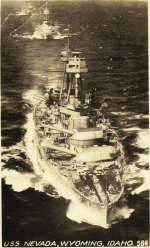 | 260k | Nevada (BB-36) steaming in line, guns trained out to starboard. Directly behind her are the Wyoming (BB-32) & Idaho (BB-42). Date approximately 1930. | USN photo courtesy of Robert M. Cieri. |
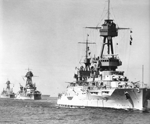 | 394k | New York (BB-34) leading Nevada (BB-36) and Oklahoma (BB-37) during maneuvers, 1932. The carrier Langley (CV-1) is partially visible in the distance. |
Naval History and Heritage Command # NH 48138 from the collections of the Naval Historical Center via Robert Hurst & Scanned from Conway's Battleships: Revised Edition, edited by Ian Sturton. |
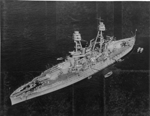 | 377k | Nevada (BB-36) at Colon Harbor, Panama, in 1933. | Photo courtesy of Vicente Pascua via Ron Armstrong. |
 | 896k | Nevada (BB-36) crew photo was taken in the early or mid-1930s, while she had Vought "Corsair" (O2U) float planes and a simple boom on the stern for aircraft recovery. During the later 30's she received a lattice crane on the stern, and carried SOC float planes, and this photo does not show those. | Photo courtesy of Micah Aschinger.
Photo i.d. & text courtesy of Chuck Haberlein.
| 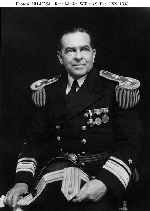 | 58k | Captain Pye was Commanding Officer of the battleship Nevada (BB-36) in 1932-33. Photographed in Special Full Dress uniform by the Ernst Studio, circa 1936.
His medals include (from left to right): Navy Cross; Spanish Campaign Medal, 1898; and World War I Victory Medal.
| Naval History and Heritage Command photo # NH 47254 courtesy of Bill Gonyo. |
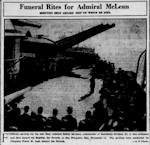 | NR | Funeral Rites for Admiral McLean
SERVICES HELD ABOARD SHIP ON WHICH HE DIED
FUNERAL service for the late Rear Admiral Ridley McLean, commander of Battleship Division No. 3, who collapsed and died aboard his flagship, the Nevada (BB-36), in San Francisco Bay, 12 November. The services were conducted by Chaplain Frank W. Lash aboard the Nevada. | Image provided by: Library of Congress, Washington, DC.
Photo & text by Evening star. [volume] (Washington, D.C.) 1854-1972, 16 November 1933, Image 4, courtesy of chroniclingamerica.loc.gov.
| 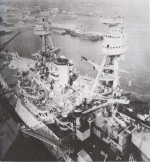 | 213k | The ship at Puget Sound Navy Yard in September, 1934. Good detail shot of the ship as she was rebuilt under the Washington Treaty. Note the antiaircraft range-finders on the foremast platform above her bridge. The director proper was located one level down, at the rear end of the range-finder platform. It's front end carried the 20-foot armored range-finder (for the secondary battery) atop her pilot house. As in the "Big Five", the three level masthead tops carried, from top to bottom, a main battery director (Mark 20), a platform for main battery control and spotting, and a platform for two secondary battery directors.
The lower mast platform carried the 12-foot range finder for the secondary battery. Just visible under the foremast itself is the diamond shaped loop of the radio direction-finder. The large oval openings just below the flack rack, which were characteristic of this class, were air intakes leading into ducts installed as part of the modernization. The port duct is visible as a square structure just below the signal searchlight forward of the flag rack. In the rear view looking forward, note the searchlight platforms on the funnel, which were characteristic of many of the rebuilt battleships, with their controls below them. | USN photo. Text courtesy of the U.S. Navy via Don Montgomery and U.S. Battleships: An Illustrated Design History by Norman Friedman. |
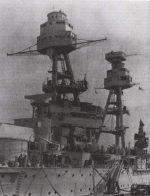 | 216k | The ship at Puget Sound Navy Yard in September, 1934. Good detail shot of the ship as she was rebuilt under the Washington Treaty. Note the antiaircraft range-finders on the foremast platform above her bridge. The director proper was located one level down, at the rear end of the range-finder platform. It's front end carried the 20-foot armored range-finder (for the secondary battery) atop her pilot house. As in the "Big Five", the three level masthead tops carried, from top to bottom, a main battery director (Mark 20), a platform for main battery control and spotting, and a platform for two secondary battery directors.
The lower mast platform carried the 12-foot range finder for the secondary battery. Just visible under the foremast itself is the diamond shaped loop of the radio direction-finder. The large oval openings just below the flack rack, which were characteristic of this class, were air intakes leading into ducts installed as part of the modernization. The port duct is visible as a square structure just below the signal searchlight forward of the flag rack. In the rear view looking forward, note the searchlight platforms on the funnel, which were characteristic of many of the rebuilt battleships, with their controls below them. | USN photo. Text courtesy of the U.S. Navy via Don Montgomery and U.S. Battleships: An Illustrated Design History by Norman Friedman. |
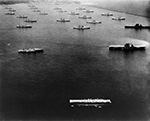 | 2.44k | Ships of the United States Fleet pictured at anchor inside the breakwater at Colon, Canal Zone, 1935.
The carriers are, front to back, Langley (CV-1), Saratoga (CV-3) and Lexington (CV-2). The two battleships beyond Lexington are the New York (BB-34) with Texas (BB-35) behind. The nearest battleship, straight up from the Langley is Pennsylvania (BB-38). The BB immediately beyond and to the left of Pennsylvania (BB-38) is California (BB-44). The remaining battleships include two New Mexico's: Mississippi (BB-41) and Idaho (BB-42), but even this higher rez shot is not clear enough to tell which is which. Also are the rest of the "Big Five" and what is probably one of the Nevada's, but that is not certain. The photo is not clear enough for positive identifications. The cruisers to the left are three Northampton's (CA-26 / 31) and the two Pensacola's (CA-24 & 25) (the pair furthest from the camera) and six Omaha's. | Photo & text i.d. courtesy of Richard M. Jensen.
Photo courtesy of National Naval Aviation Museum (NNAM) photo (# 1996.488.001.006) courtesy of Fabio Pena. |

013315 |
NR |
Seven U. S. Ships Due to Be Scrapped for New Ones
Seven of Uncle Sam's l5 biggest battleships are due to be scrapped and replaced with new ones at cost of $50,000,000 each, if Japan fails to withraw its's denunciation of Washington naval treaty, which expires 31 December 1936, it is indicated in Washington. The treaty forbade construction of new battleships, and limited construction to war vessels of 10,000 tons or less. The ships scheduled to be replaced are shown from left to right & top to bottom: Texas (BB-35) ,Arizona (BB-39) & New York (BB-34).
Oklahoma (BB-37), Arkansas (BB-33), Nevada (BB-36) & Pennsylvania (BB-38). (Central Press Photo) |
Image and text provided by University of North Carolina at Chapel Hill Library, Chapel Hill, NC.
Photo by Henderson Daily Dispatch. (Henderson, N.C.) 1914-1995, 23 March 1935, Image 6, courtesy of chroniclingamerica.loc.gov. |
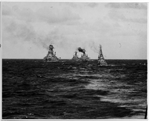
013987 | 900k | The Arizona (BB-39) (L) with (L-R), Tennessee (BB-43), Nevada (BB-36) and Brant (AM-24) en route to Hawaii for fleet maneuvers, 1935. | Photo NH 50258, courtesy of history.navy.mil
|
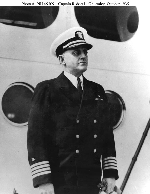 | 51k | Lieutenant Commander Ghormley spent most of World War I aboard the battleship Nevada (BB-36) as a flag aide. He returned as the Commanding Officer of Nevada in 1935 as Captain and a year later in 1936 returned to the U.S. Fleet staff. In the rank of Vice Admiral, he served as Commander South Pacific Area and South Pacific Force in June-October 1942, during the critical early stages of the campaign to seize and hold Guadalcanal and Tulagi. Photographed in October 1935, while he was Commanding Officer of Nevada.
| Naval History and Heritage Command photo # NH 49309 & via Bill Gonyo. |
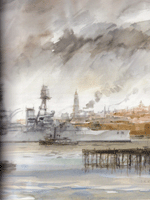
013639 | 1.60k | A painting by Ian Marshall of the battleship Nevada (BB-36) at Charlestown, Navy Yard, 1935. | Text Images from Victory at Sea: Naval Power and the Transformation of The Global Order in World War II, by Paul Kennedy with paintings by Ian Marshall. Pub: Yale University Press, New Haven and London. Library of Congress Control Number: 2021454849, via Robert Hurst.
|  | 1.80k | 1936 photo of Battleship Row, Pearl Harbor. Among the ships in the harbor are: Front and center a Northampton class CA, most likely the Chester (CA-27).
The two New Orleans (CA-32) class cruisers on the far left are the Minneapolis (CA-36) nearer the camera with New Orleans (CA-32) behind. Both have the curved-faced turrets, limiting them to the CA-32/34/36 group. Within that group, only New Orleans lacked the glassed-in navigation bridge (below the pilothouse), and minor superstructure variations point to the other being Minneapolis rather than Astoria (CA-34).
The battleships from left to right: Colorado (BB-45), or West Virginia (BB-48), outboard of Idaho (BB-42), Nevada (BB-36), outboard of Mississippi (BB-41), New Mexico (BB-40), outboard of Maryland (BB-46) or California (BB-44).
On the far right is the Hospital ship Relief (AH-1) with two unidentified ships ahead and to her port side.
| Text courtesy of David Johnston, (USNR), Aryeh Wetherhorn (USNR) & Richard Jensen.
Photo courtesy of Edward Cwalinski, submitted by Barry Litchfield. |
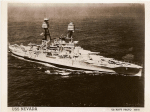 | 1.78k | Nevada (BB-36) during the later 1930s. | Official USN photo courtesy of Derek Strahan. |
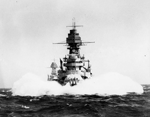 | 776k | Leading Nevada (BB-36), Arizona (BB-39) heads into a sea. Note the concentration dial above the rangefinder. | USN photo courtesy Pieter Bakels via 'Fighting Fleets' by R.S. Critchell and H.H. Rimington, copyright 1942. |
 | 558k | A U.S. Navy Vought UO-1 of Observation Squadron VO-6 attached to the battleship Nevada (BB-36). | USN photo by R.S. Critchell and H.H. Rimington, via Robert Hurst. |
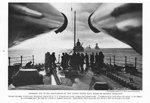 | 654k | STANDING OUT TO SEA, BATTLESHIPS OF THE U.S. NAVY STEAM IN CRUISING FORMATION
Beneath gleaming 14 inch guns, bluejackets aboard the Pennsylvania (BB-38) secure anchor and ground tackle. Commissioned in 1916 before the advent of the clipper, or overhanging bow, the ship has a blunt or overhanging forecastle. Immediately ahead steams the New Mexico (BB-40) with the Nevada (BB-36) at the right. | USNI Photo Navy Recruiting Bureau, N.Y.
| 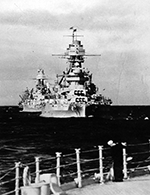 | 486k | Arizona (BB-39) leading Nevada (BB-36) and the Tennessee (BB-43) and a New Mexico class battleship underway.
| USN photo # 80-G-456504 from the National Museum of the U.S. Navy via flickr.com.
|
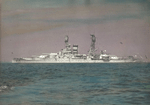 |
373k |
Colorful Nevada (BB-36) circa 1930's. |
Authors collection photo. |
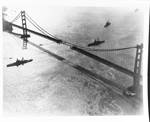
013934 | 6.44k | U.S. Fleet battleships steam under the incomplete Golden Gate Bridge, circa November 1936. Leading ship is Arizona (BB-39), followed by Nevada (BB-36), Maryland (BB-46) and Texas (BB-35) . | Photo NH 95911, courtesy of history.navy.mil
|
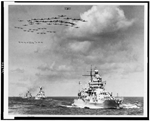 | 463k | Probable front and rear photos here and below showing formations of aircraft flying over U.S. Navy battleships during exercises at sea, 1938 / 1939.
Pictured here is the New Mexico (BB-40) in the van with other battleships of the Pacific Fleet and a carrier air group, led by the Air Group Commander in a Curtiss SBC Helldiver.
The aircraft following are:
A torpedo squadron of eighteen Douglas TBD-1s;
A bombing squadron of eighteen Northrop BT-1s;
A scouting squadron eighteen Curtiss SBCs;
A fighting squadron of eighteen Grumman F2F-1s or F3F-3s from either the Yorktown (CV-5) or F3F-2s from the Enterprise (CV-6), plus possibly nine additional aircraft.
The Yorktown and Enterprise were the only two carriers whose bombing squadrons were equipped with the Northrop BT-1.
The text for the photo reads:
"The Navy uses enormous amounts of rubber. At least seventy-five tons of rubber, enough to makes 17,000 tires, are used in the construction of each of these battleships. Tons more are needed for the naval planes that are making history over the world. Medical and communication requirements--and countless other needs of the Navy--are met."
The lead BB looks like Mississippi (BB-41) followed by Maryland (BB-46) (rangefinder on Turret II). My first impression of the Tennessee class (BB-43 /44) is the Tennessee (BB-43), but that is not a certain ID from this photo alone. Fourth is the Oklahoma (BB-37) (no birdbath). Aside from the DD now in the lead, I see nothing in the head-on shot aerial that positively differs from the ID's of the first 4 BB's in the first photo. Of course, in the aft aerial shot, BB #5 is the California (BB-44), ID'd by the enlarged flag bridge, lending support to BB #3 in the first photo being Tennessee. Everything I see supports these three photos all being part of the same operation with at least the first 5 BB's remaining in the same order. |
Photograph # LC-USE64 - DC-000944 & partial text courtesy of memory.loc.gov.
Battleship i.d. & text courtesy of Richard Jensen.
Aircraft i.d. & text & timeline courtesy of Alan Moore via the following sources: Airplane i.d.: Yorktown Class Carriers (Warship Pictorial No. 9) by Steve Wiper, Tucson, AZ: Classic Warships Publishing, 2000. & That Gallant Ship: U.S.S. Yorktown (CV-5) by Robert Cressman, Missoula, MT: Pictorial Histories Pub Co, 1985. Timeline from Battleship Arizona: An Illustrated History by Paul Stillwell, Annapolis, MD: Naval Institute Press, 1991. |
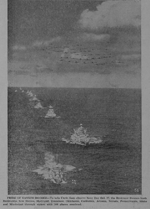
01yankeedoodle |
441k |
PRIDE OF YANKEE DOODLE-To help Uncle Sam observe Navy Day, 27 October 1939: the Destroyer Downes (DD-375) leads Battleships New Mexico (BB-40), Maryland (BB-46), Tennessee (BB-43), Oklahoma (BB-37), California (BB-44), Arizona (BB-39), Nevada (BB-36), Pennsylvania (BB-38), Idaho (BB-42) and Mississippi (BB-41) through waters with 100 planes overhead. |
Photo courtesy of umich.edu |
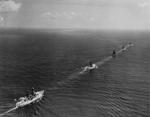 | 1.62k | Probable front and rear photos here and above showing formations of aircraft flying over U.S. Navy battleships during exercises at sea, 1938 / 1939.
New Mexico (BB-40) is leading the BB column while the remaining battleships have dual masthead fire control structures.
The air group formation in the two photos appears to be similar. The composition of 18 TBDs, 18 BT-1s, 18 SBCs, and 27 fighters is easier to distinguish in the front/surface view. I'm assuming, based on total aircraft count alone, that the formation in the rear/aerial view is the same. (The perspective makes it difficult to sort the monoplanes and biplanes into their respective types.) The only difference is that in the front/surface view the formation is lead by a Curtiss SBC Helldiver (likely the Air Group Commander) but in the rear/aerial view that lead Helldiver is not present. I suppose it's possible that the photographer was in that Helldiver's rear seat.
What stands out for me is the presence of nine extra fighters beyond the normal squadron composition of 18, as seen in the other three squadrons in this formation. | Photo i.d courtesy of Chuck Haberlein, Richard Jensen, Aryeh Wetherhorn, & Tracy White @ Researcher @ Large.
Battleship i.d. & text courtesy of Richard Jensen.
Aircraft i.d. & text courtesy of Alan Moore.
US Navy and Marine Corps Museum/Naval Aviation Museum, photo No. 2008.104.001.234. |
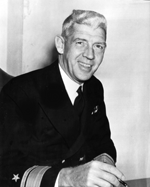 | 747k | VADM Francis Warren Rockwell commanded Nevada (BB-36) from 1939 to 1941. | Photo courtesy of Bill Gonyo.
| 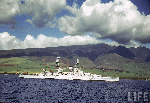 | 151k | Nevada (BB-36) off the coast of Hawaii during the US Navy's Pacific fleet maneuvers.
My primary interest is in naval aviation, and the aircraft markings are important. Having this photo in color facilitates the identification. The red tails on the Curtiss SOC biplanes indicate that these are from VO-1 (Observation [Squadron] One), and therefore the ship is from Battleship Division One. (The aircraft's squadron number corresponds to the ship's division number.) BatDivOne consisted of Arizona (BB-39), Nevada and Pennsylvania (BB-38) (in that order, which is important.)
The next bit of information comes from the color of the aircraft cowls. The two turret-mounted aircraft have covers on their cowls (and canopies), but the stern-mounted aircraft is uncovered and shows a white cowl, making it from the second section. The aircraft's section corresponds to the ship's position in the division. As noted above, the second ship in BatDivOne is Nevada.
Oklahoma was in BatDivTwo: her aircraft would have had white tails.
If you have the close up color photos of the SOC on the Idaho (BB-42) you can apply the same rules (although it's a much simpler identification since you can read the ship's name on the fuselage). The blue tail signifies VO-3. The red cowl is the first section. Idaho was the flagship of BatDivThree.
If you want to be precise, the aircraft on the the Idaho turret is an SON-1, a Naval Aircraft Factory-built version of the SOC.
| Photographer: Carl Mydans, courtesy of life.time.
Text courtesy of Alan Moore. |
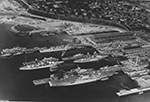 | 465k | View of the U.S. Puget Sound Navy Yard, Bremerton, Washington, in 1940. Identifiable ships include (front to back): the aircraft carrier Lexington (CV-2); a New Orleans-class heavy cruiser; a Tennessee class (BB-43 / 44) battleship (left); a Nevada-class (BB-36 / 37) battleship; a Brooklyn-class light cruiser; two Farragut-class destroyers; a Northampton-class heavy cruiser is in a drydock; one of the destroyers in the foreground is probably Charles F. Hughes (DD-428) which was built at the Puget Sound Naval Shipyard and commissioned on 5 September 1940. The other could be Monssen (DD-436), commissioned on 14 March 1941. The construction of Drydock No. 5 was started in the background. | National Archives Identifier: 6036986
Photo courtesy of catalog.archives.gov |
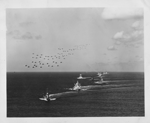 | 1.31k | Between 9 & 13 September 1940 the Arizona (BB-39) was under way with other ships of the US Fleet for simulated fleet engagement. She is pictured here in company with other ships of the Pacific Fleet taken during Fleet Ops. and at least one carrier air group. | US Navy and Marine Corps Museum/Naval Aviation Museum, Photo No. 2008.104.001.235 courtesy of Alan Moore.
Text & photo i.d. courtesy of Alan Moore via Battleship Arizona: An Illustrated History by Paul Stillwell, Annapolis, MD: Naval Institute Press, 1991. |
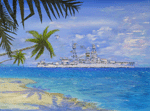 | 1.35k | Painting by the artist Wayne Scarpaci titled 'Aloha Oi' and shows the Nevada (BB-36) departing Hawaii in the halcyon days of early 1940. The ships of the US fleet remained painted in 'Pre-war White' (Pale Gray) until September-October 1940, when war with Japan became a matter of when not if.
| Painting courtesy of artbywayne.com. |
 | 674k | Starboard profile of the Arizona (BB-39) at Puget Sound Navy Yard, 18 January 1941. The stern section of the Nevada (BB-36) and her tripod masts rise up behind the Arizona. | USN photo # 123-41 courtesy of Seattle NARA via Tracy White @ Researcher @ Large.
| 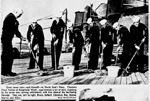 | NR | Gives seven sons—and himself to Uncle Sam's Navy.
Clarence Floyd Patten of Ridgefield, Wash., superintends a bit of deck swabbing by his seven sons serving enlistments with him aboard the battleship Nevada (BB-36). They are, left to right, Bruce, Gilbert, Clarence, Ray, Myrne, Marvin and Allen. | Image and text provided by Library of Congress, Washington, DC.
Photo from Evening Star. [volume] (Washington, D.C.) 1854-1972, 28 September 1941, Image 111, courtesy of chroniclingamerica.loc.gov.
|
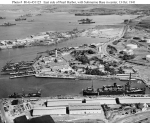 |
144k |
Aerial view of the Submarine Base,Pearl Harbor, Oahu, Hawaii, with part of the supply depot beyond and the fuel farm at right, looking north on 13 October 1941. Note the fuel tank across the road from the submarine base, painted to resemble a building. The building beside the submarine ascent tower (in left center, shaped like an upside down "U") housed the U.S. Fleet Headquarters at the time of the Japanese attack on 7 December 1941. Office of Admiral Husband E. Kimmel, the Fleet's Commander in Chief, was in the upper left corner of the building's top floor.
Wharton (AP-7) is in right foreground. Among the submarines at the base are Tuna (SS-203), Gudgeon (SS-211), Argonaut (SS-166), Narwhal (SS-167), Triton (SS-201) and Dolphin (SS-169). Holland (AS-3) and Niagara (PG-52) are alongside the wharf on the base's north side. In the distance (nearest group in upper left) are the battleship Nevada (BB-36), at far left, Castor (AKS-1) and the derelict old minelayer Baltimore. Cruisers in top center are Minneapolis (CA-36), closest to camera, and Pensacola (CA-24), wearing a Measure 5 painted "bow wave". |
Official USN photo # 80-G-451125, now in the collections of the National Archives. |

013600b | 1.15k | Painting by the artist Joseph Reindler titled SOMEWHERE OFF HONOLULU : Heavy elements of the US Pacific Fleet on maneuvers; Nevada (BB-36) leads Maryland (BB-46) (second-nearest) and Tennessee (BB-43) (at distance). Another generic scene, circa Winter 1941.
Besides Nevada, details of armament coupled with nuances of the Measure-1 camouflage worn by these ships, as well as the obvious lines of anti-torpedo blisters also permit clear identification of Maryland at least – given that of the 16-inch gunned latter three of the ‘Big-5’ standard battleships, West Virginia (BB-48) was not fitted with anti-torpedo blisters by Winter of 1941; and Colorado (BB-45) was in refit at the time represented by this drawing. Admittedly there was very little I could add on so small a sketch to differentiate between Tennessee and her sister California (BB-44).
The International Code of Signals still reads well in black & white – which is by design not accident; thereby the signal Nevada makes at her Starboard foretop signals yard reads : “PREP-BAKER-TARE, FIRST-REPEAT-LOVE-ZED, X-RAY-ONE-SEVEN-NINE”. Or, translated: “TOGETHER TURN TO COURSE TRUE ONE-SEVEN-NINE”. It was a bit of fun working an actual message into so small a drawing. Of course with the signal still hauled up Nevada has yet to actually execute her own turn – and with Maryland and Tennessee in line astern still wearing around onto the same heading the scene would no doubt make for some fun between the respective Officers of the Deck and Signals Yeomen in all three ships. But no doubt with war brewing all crews were being put through their paces. | Painting courtesy of Joseph Reindler. |
WW II
|
 |
2.94k |
Japanese Attack on Pearl Harbor, 7 December 1941. Imperial Japanese Navy aircraft carriers in dawn fly-off for Pearl Harbor. |
Artwork by John Hamilton from his publication, "War at Sea," pg. 68-69.
USN photo # 80-142-H, courtesy of the U.S. Navy Art Gallery from the National Museum of the U.S. Navy, courtesy of flickr.com.
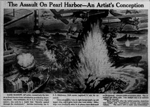
014325 |
NR |
The Assault On Pearl Harbor—An Artist's Conception
HANK BARROW, AP artist, reconstructs the battle at Pearl Harbor from information provided by Secretary Knox. One battleship, the Arizona (BB-39), (right center), was sunk by a bomb that "literally passed through the smokestack." Another battleship, the Oklahoma (BB-37), (left center,capsized. It can be repaired. Three destroyers (one in right foreground), an old target ship, and a mine layer also went down. Other ships were damaged, many U. S. planes were destroyed on the ground. Almost 2,900 servicemen died The attackers lost three subs (one midget sub is at extreme right) & 41 aircraft.
Knox said that after the initial surprise, American men fought with "magnificent courage and resourcefulness. The men's will to resist was tremendous...
|
Image and text provided by University of Florida.
Photo from The Key West Citizen. [volume] (Key West, Fla.) 1879-current, 22 December 1941, Image 1, via chroniclingamerica.loc.gov.
|
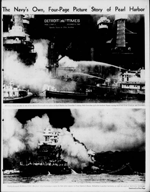
014316s |
2.14k |
The Navy's Own, Four-Page Picture Story of Pearl Harbor
Old Glory flying proudly in one of her darkest hours and over sailors at Pearl Harbor last 7 December risking their lives close up to the bomb-set flames roaring from both West Virginia (BB-48) and Tennessee (BB-43).
Slightly-damaged 31,000-ton Maryland (BB-46) (first battleship to rejoin the fleet after repairs) in Pearl Harbor's flames. Behind her is another battleship, at right the capsized battleship Oklahoma (BB-37). |
Image and text provided by Central Michigan University, Clark Historical Library.
Photo from Detroit Evening Times. (Detroit, Mich) 1921-1958, 06 December 1942, FINAL, Images 21, 22, 23, & 24, via chroniclingamerica.loc.gov.
|
 |
1.67k |
Battleship row in flames. |
Artwork by John Hamilton from his publication, "War at Sea," pg. 74-75.
USN photo # 80-142-I, courtesy of the U.S. Navy Art Gallery from the National Museum of the U.S. Navy, courtesy of flickr.com.
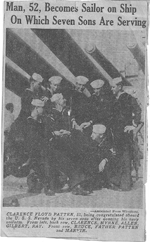 |
357k |
The 7 Patton brothers and their father aboard the Nevada (BB-36). |
Authors collection photo. |
| 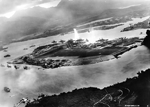 |
|
Photograph taken from a Japanese plane during the torpedo attack on ships moored on both sides of Ford Island shortly after the beginning of the Pearl Harbor attack. View looks about east, with the supply depot, submarine base and fuel tank farm in the right center distance. A torpedo has just hit West Virginia (BB-48) on the far side of Ford Island (center). Other battleships moored nearby are (from left): Nevada (BB-36), Arizona (BB-39), Tennessee (BB-43) (inboard of West Virginia), Oklahoma (BB-37) (torpedoed and listing) alongside Maryland (BB-46), and California (BB-44). On the near side of Ford Island, to the left, are light cruisers Detroit (CL-8) and Raleigh (CL-7), target and training ship Utah (AG-16) and seaplane tender Tangier(AV-8). Raleigh and Utah have been torpedoed, and Utah is listing sharply to port. Japanese planes are visible in the right center (over Ford Island) and over the Navy Yard at right. U.S. Navy planes on the seaplane ramp are on fire. Japanese writing in the lower right states that the photograph was reproduced by authorization of the Navy Ministry. |
Text courtesy of wikipedia.com.
Official USN photograph NH 50930.
|
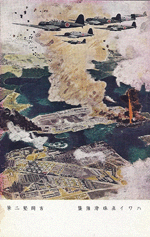 |
1.01k |
Japanese post card of bombers over Pearl Harbor, 7 December 1941. |
Photo courtesy of Arnold Putnam.
|
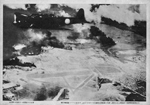 |
3.24k |
Japanese attack on Pearl Harbor - Hickam Field. |
Photo courtesy of Arnold Putnam.
| 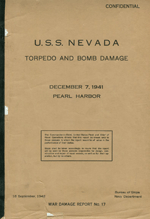 | 111k | Nevada (BB-36) 51 photo Pearl Harbor Damage Report.
| Courtesy of Tracy White @ researcheratlarge.com |
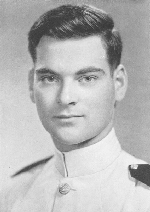 | 65k | Joseph K. Taussig, Jr. (Class of '41) received the Navy Cross for heroism on board Nevada (BB-36) at Pearl Harbor. He was perhaps best known as the officer of the deck aboard Nevada when Japanese planes attacked "Battleship Row" on 7 December 1941. Fourteen bombs hit Nevada that day; 43 people were killed and 118 wounded.
After sounding the alert on his ship, the 21-year-old ensign manned a starboard anti-aircraft gun and refused to leave his post after taking a hit to his left leg. In his own words, "I was directing fire at the outset of the attack when I don't know what hit me, something went completely through my thigh. They ordered a cot for me, and I just continued to control the gun batteries. Some enlisted men brought a stretcher and I stayed up there until the (ship's) whole structure caught fire. They brought me down through the fire. The Navy said I was decorated because I refused to leave my post."
"This is a direct order," he said to BM1 Bob Norman, who was trying to carry him away to safety. "Leave me alone!" "I'm sorry sir," replied Norman, "but this is one order I'm going to have to disobey." Facing a fire that severely damaged the ship, Taussig resisted but was forcefully carried below decks by his shipmates where he was treated for his injuries. Besides receiving the Navy Cross, the Navy's second highest award for valor following the Medal of Honor in precedence, Taussig was also awarded the Purple Heart. He stayed in several hospitals until April 1946, when his left leg was amputated. He returned to active duty three days later. By the time he finally retired from active naval service in 1954 he was, at age 34, the youngest captain in the Navy.
Joseph K. Taussig, Jr. comes from a Navy family with a large tradition of service to our nation. His grandfather was Rear Admiral Edward David Taussig and his father was Rear Admiral Joseph K. Taussig Sr. | Photo courtesy of Bill Gonyo. |
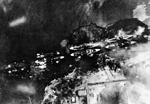 |
3.95k |
Vertical aerial view of "Battleship Row", beside Ford Island, during the early part of the horizontal bombing attack on the ships moored there. Photographed from a Japanese aircraft. Ships seen are (from left to right): Nevada (BB-36), Arizona (BB-39) with Vestal (AR-4) moored outboard; Tennessee (BB-43) with West Virginia (BB-48) moored outboard; Maryland (BB-46) with Oklahoma (BB-37) moored outboard; and Neosho (AO-23), only partially visible at the extreme right. A bomb has just hit Arizona near the stern, but she has not yet received the bomb that detonated her forward magazines. West Virginia and Oklahoma are gushing oil from their many torpedo hits and are listing to port. Oklahoma's port deck edge is already under water. Nevada has also been torpedoed.
Japanese inscription in lower left states that the photograph has been officially released by the Navy Ministry. Also at NHHC as NH 50472.
From the translated Japanese caption, "Alas, the spectacle of the American battleship Fleet in its Dying Gasp. The attack of our assault force was extremely accurate and achieved direct hits with all bombs. The leading ship of the Oklahoma Class is already half sunk. The Maryland type and the Pennsylvania type are blowing up from several direct hits. The ships crumble and their hulls are twisted and keeling over. Crude oil gushes forth fearfully. This view of the wretched enemy's capital ships which were converted into a sea hell was photographed from directly overhead by the heroes of our calm, valorous attack force." |
USN photo # 80-G-30551, courtesy of the National Museum of the U.S. Navy, via flickr.com. |
 | 317k | The Nevada (BB-36) at Pearl Harbor at 0903 when she came under attack by Aichi-99 Vals from Kaga. | Painting courtesy of artbywayne.com. |
 | 1.26k | "The Japanese Sneak Attack on Pearl Harbor". Charcoal and chalk by Commander Griffith Bailey Coale, USNR, Official U.S. Navy Combat Artist, 1944.
This artwork "... shows the destruction wrought on ships of the U.S. Pacific Fleet attacked in their berths by scores of enemy torpedo planes, horizontal and dive bombers on December 7, 1941.
At the extreme left is the stern of the cruiser Helena (CL-40), while the battleship Nevada (BB-36) steams past and three geysers, caused by near bomb misses, surround her. In the immediate foreground is the capsizing mine-layer Oglala (CM-4). The battleship to the rear of the Oglala is the California (BB-44), which has already settled.
At the right, the hull of the capsized Oklahoma (BB-37) can be seen in front of the Maryland (BB-46); the West Virginia (BB-48) in front of the Tennessee (BB-43); and the Arizona (BB-39) settling astern of the Vestal (AR-4), seen at the extreme right.
The artist put this whole scene together for the first time in the early summer of 1944, from 1010 Dock, in Pearl Harbor, where he was ordered for this duty.
Coale worked under the guidance of Admiral William R. Furlong, Commandant of the Pearl Harbor Navy Yard, who stepped from his Flagship, the Oglala, as she capsized." (quoted from the original Combat Art description). | Official USN photo # KN-32031, courtesy of the U.S. Navy Art Center, Washington, D.C. |
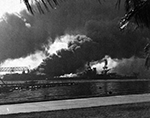 | 2.06k | Nevada (BB-36) afire off the Ford Island seaplane base, with her bow pointed up-channel. Shaw (DD-373) is burning in the floating dry dock YFD-2 in the left background. Photographed from Ford Island, with a dredging line at left. | USN photo # 80-G-32457 from the National Museum of the U.S. Navy via flickr.com. |
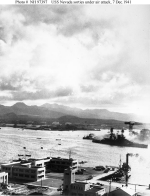 | 82k | Nevada (BB-36) headed down channel past the Navy Yard's 1010 Dock, under Japanese air attack during her sortie from "Battleship Row". A camouflage Measure 5 false bow wave is faintly visible painted on the battleship's forward hull. Photographed from Ford Island. Small ship in the lower right is Avocet (AVP-4). Note fuel tank "farm" in the left center distance, beyond the Submarine Base. | Official USN photo # NH 97397, from the collections of the Naval Historical Center. |
 | 101k | Oil on canvas painting by the artist Stan Stokes entitled "A Dash For Freedom", depicting the famous sortie of the Nevada (BB-36) during the attack on Pearl Harbor. The wrecked Arizona's (BB-39) foremast is leaning as a result of the collapse of the hull structure below its front leg, following the explosion of the ship's forward magazines. | Photo and partial text courtesy of oldgloryprints.com
|
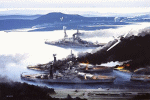 | 63k | Oil on canvas painting by the artist Ivan Berryman entitled "The Raid on Pearl Harbor, 7th December 1941," depicting the view across 'Battleship Row', viewed from above Ford Island as the Nevada (BB-36) gallantly makes her break for the open sea, coming under heavy attack from Japanese A6M2s from the carrier Hiryu. The Nevada was eventually too badly damaged to continue and was beached to avoid blocking the harbor entrance. In the immediate foreground, the lightly damaged Tennessee (BB-43) is trapped inboard of West Virginia (BB-48) which has sunk at her moorings, leaking burning oil and hampering the daring operations to pluck trapped crew members from her decks, while just visible to the right is the stern of the Maryland (BB-46) and the capsized Oklahoma (BB-37).
| Photo and partial text courtesy of military-art.com.
|
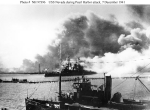 | 87k | Nevada (BB-36) headed down channel after being intensely attacked by Japanese dive bombers. Photographed from Ford Island, with Avocet (AVP-4) in the foreground and the dredge line in the middle distance. | Official USN photo # NH 97396, from the collections of the Naval Historical Center. |
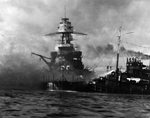 | 483k | Nevada (BB-36) aground and burning off Waipio Point, after the end of the Japanese air raid. Ships assisting her, at right, are the harbor tug Hoga (YT-146). | USN photo # 80-G-32747, courtesy of the National Museum of the U.S. Navy, via flickr.com.
| 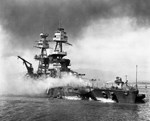 | 3.0k | Nevada (BB-36) beached and burning after being hit forward by Japanese bombs and torpedoes. Her pilothouse area is discolored by fires in that vicinity. The harbor tug Hoga (YT-146) is alongside Nevada's port bow, helping to fight fires on the battleship's forecastle. Note channel marker buoy against Nevada's starboard side. | Official USN photo # 80-G-19940, from the National Naval Aviation Museum, courtesy of Bill Gonyo. |
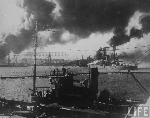 | 110k | American battleship Nevada (BB-36) (R) burning after being hit by bombs & torpedoes during the Japanese surprise attack on Pearl Harbor. | Photo courtesy of life.time.com |
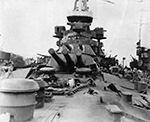 | 771k | View of the wrecked ships at the Navy Yard. Nevada (BB-36), bow looking aft. Photographed on 12 December 1941.
| Official USN photo # 80-G-242087, courtesy of the National Museum of the U.S. Navy, via flickr.com.
| 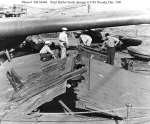 | 126k | Damage to the forecastle deck of Nevada (BB-36), caused by the explosion of a Japanese bomb below decks. Gun barrels of the battleship's forward 14"/45 triple turret are in the background. Photographed on 12 December 1941 from on board Rail (AM-26), which was tied up alongside Nevada's starboard bow, assisting with salvage efforts. Note officer in center, wearing a .45 caliber pistol. | Official USN photo # NH 64484, from the collections of the Naval Historical Center. |
 | 72k | This photo is looking down the channel at Pearl Harbor on 8 December 1941. The Nevada (BB-36) is visible at the far right of the photo, aground at Waipio Point being assisted by salvage craft. After first running aground at Hospital Point, to the left, the ship was moved by tugs to her present location to avoid bottle-necking the channel for ship traffic. | National Archives photo # NA80-G-32504, contributed by Mike Green. |
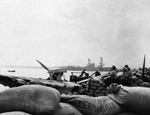 |
780k |
Sandbagged .30 caliber machine gun emplacement with gun crew on alert, at the seaplane base near Ford Island's southern tip, soon after the Japanese attack. Note, the beached battleship Nevada (BB-36) beyond. Sandbags are marked "Permanente" |
USN photo # 80-G-32487 from the National Museum of the U.S. Navy, courtesy of flickr.com.
Salvage & Repair
|
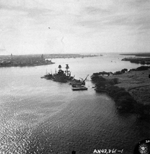 |
595k |
Start of the salvage and repair of the Nevada (BB-36). |
USN photo # 80-G-387563 from the National Museum of the U.S. Navy, courtesy of flickr.com.
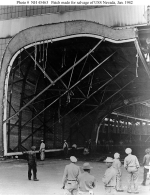 | 103k | Large patch fabricated by the Pearl Harbor Navy Yard to temporarily seal torpedo damage inflicted on Nevada's (BB-36) port side during the Japanese attack of 7 December 1941. Photographed when the patch was completed in early January 1942.
After unsuccessful attempts to attach this patch to the ship and attain a watertight seal, it was removed before Nevada drydocked on 18 February 1942.
| Official USN photo # NH 45463, from the collections of the Naval Historical Center. |
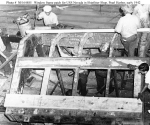 | 95k | Window frame patch being fabricated in the Shipfitter Shop at the Pearl Harbor Navy Yard in early January, 1942. It was used to temporarily seal a bomb hole in Nevada (BB-36) port bow while she was under salvage. | National Archives photo # NH 64485, courtesy of Mike Green. |
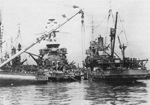 | 220k | Divers from the Ortolan (ASR-5) (left) and the Widgeon (ASR-1) work with the crane barge Haviside to attach the big patch to the Nevada (BB-36). The Ortolan had just arrived to the Waipio Point location, waiting for new plans to be issued to raise the Oglala (CM-4). | National Archives photo from the book "Resurrection-Salvaging the Battle Fleet at Pearl Harbor", by Dan Madsen, courtesy of Mike Green. |
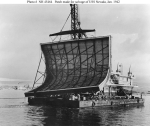 | 73k | The Hawaiian Dredging Company crane barge Gaylord transports the large patch to Nevada's (BB-36) resting place in Pearl Harbor, where it was used in an attempt to seal torpedo damage received on 7 December 1941. Photographed in January 1942, the patch had been fabricated by the Pearl Harbor Navy Yard. After unsuccessful attempts to attach it to the ship and attain a watertight seal, it was removed before Nevada was dry-docked on 18 February 1942. | National Archives Photo # NH 45464, courtesy of Mike Green. |
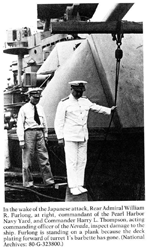
013656 | 494k | Commander Harry L. Thompson and Adm. Furlong inspecting damage on Nevada (BB-36) shortly after the Pearl Harbor attack. At the time that the photograph was taken, Cdr. Thompson was acting CO of Nevada. I believe that the photograph was probably taken in February 1942 after Nevada was drydocked for repairs. | USN photo courtesy of Tony DiGiulian & navweaps.com.
| 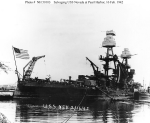 | 79k | Nevada (BB-36) in Pearl Harbor on 16 February 1942, while she was being prepared for drydocking after she was re-floated. She entered the Pearl Harbor Navy Yard's Drydock Number Two on 18 February. | Official USN photo # NH 50103, from the collections of the Naval Historical Center. |
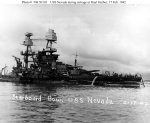 | 71k | The Nevada (BB-36) in Pearl Harbor on 17 February 1942, while she was being prepared for dry-docking after she was re floated. She entered the Pearl Harbor Navy Yard's Dry-dock Number Two on the following day. | National Archives Photo # NH 50105, courtesy of Mike Green. |
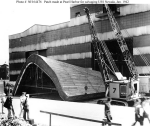 | 98k | Large patch fabricated by the Pearl Harbor Navy Yard to temporarily seal torpedo damage inflicted on Nevada's (BB-36) port side during the Japanese attack of 7 December 1941. Photographed when the patch was completed in early January 1942. This patch was not able to make a watertight seal and was removed before the ship was drydocked on 18 February 1942. Note photographer Tai Sing Loo at work in the lower left. | Official USN photo # NH 64476, from the collections of the Naval Historical Center. |
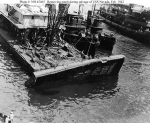 | 106k | The Hawaiian Dredging Company crane barge Gaylord and several tugs work to remove the large temporary patch from Nevada's (BB-36) port side, while she was being prepared for dry-docking on 17 February 1942. The patch had been fabricated by the Pearl Harbor Navy Yard but was not able to attain a watertight seal. | National Archives Photo # NH 45465, courtesy of Mike Green. |
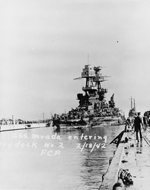 | 943k | Entering Drydock # Two, at Pearl Harbor Navy Yard, 18 February 1942. Sunk as a result of damage received in the 7 December 1941 Japanese air raid, she was refloated on 12 February 1942. Note oil staining along her hull, marking her waterline while she was sunk. | Text courtesy of # NH 83056.
USN photo courtesy of Scott Koen & ussnewyork.com. |
 | 747k | Nevada (BB-36) safe in drydock, 18 February 1942. | USN photo courtesy of Pieter Bakels. |
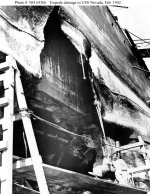 | 120k | Hole in the ship's port side, between about Frame 38 and Frame 46, caused by a Japanese Type 91 aerial torpedo that hit her during the 7 December 1941 air raid. Photographed on about 19 February 1942, in Pearl Harbor Navy Yard's Drydock Number Two. The battleship's side armor is visible inside the hole's upper section. | Official USN photo # NH 64306, from the collections of the Naval Historical Center. |
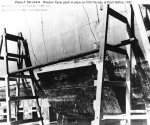 | 120k | Window frame patch in place on Nevada's (BB-36) port bow, circa 19 February 1942, after she had been refloated and placed in Pearl Harbor Navy Yard's Drydock Number Two. This patch was used to seal a bomb hole in the turn of the bilge at about Frame 7. | Official USN photo # NH 64494, from the collections of the Naval Historical Center. |
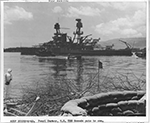 | 512k | Nevada (BB-36) departing Pearl Harbor after temporary repair of bomb and torpedo damage received during the Japanese air raid on 7 December 1941. Photograph is dated 19 April 1942, possibly taken as the ship was leaving Pearl Harbor for a trial run. The Pearl Harbor Navy Yard's work on her was completed on 22 April, after which she steamed to the Puget Sound Navy Yard for permanent repairs and modernization. | Photographed by Ph2c H.S. Fawcett USN. Official USN photo # 80-G-464702, from National Archives and Records Administration (NARA), College Park, Maryland, courtesy of Sean Hert. |
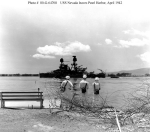 | 85k | Nevada (BB-36) departing Pearl Harbor after temporary repair of bomb and torpedo damage received during the Japanese air raid on 7 December 1941. Photograph is dated 19 April 1942, possibly taken as the ship was leaving Pearl Harbor for a trial run. The Pearl Harbor Navy Yard's work on her was completed on 22 April, after which she steamed to the Puget Sound Navy Yard for permanent repairs and modernization. Note sailors watching, each carrying a gas mask container. | Photographed by Ph2c H.S. Fawcett USN. Official USN photo # 80-G-64768, now in the collection of the National Archives. |
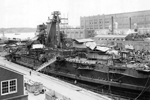
013688h | 677k | Nevada (BB-36) summer 1942 being reconstructed after Pearl Harbor. The superstructure has totally been removed, as well as the main battery, secondary battery and turret roofs. Notice the miles of hoses and temporary structures on deck. | Source: Puget Sound Navy Yard photo courtesy of Mike Green.
|
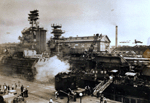
013645f |
1.63k |
On this date, 25 August 1942, Nevada (BB-36) was at PSNS & IMF on the Waterfront for repairs. |
Source: Puget Sound Navy Museum courtesy of Mike Green.
| 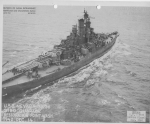 | 1.60k | 14 December 1942 photo of the Nevada just after post-Pearl Harbor modifications, and before painting into Measure 22 and having the two 40mm quads athwart turret 3 moved up and forward for better arcs of fire. | Photo & text courtesy of David Buell. |
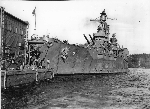 | 280k | Bow view of the Nevada (BB-36) port side. Puget Sound Navy Yard, 15 December 1942. | USN photo courtesy of Pieter Bakels. |
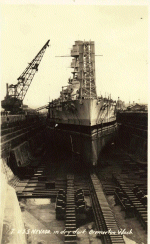 | 154k | The Nevada (BB-36) in dry dock at Puget Sound Navy Yard undergoing repairs from the attack at Pearl Harbor. | USN photo courtesy of Robert M. Cieri. |
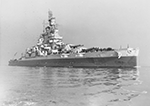 | 735k | Nevada (BB-36) Overhauled at the U.S. Navy Dry Dock, Boston Navy Yard. | National Archives Identifier: 6882570
Photo courtesy of catalog.archives.gov |
 | 133k | Photo of Task Group 51, the Attu force, May 1943.
Pennsylvania (BB-38) in the foreground with the battleships Idaho (BB-42) and Nevada (BB-36) in the background. The Nassau (CVE-16) is pictured astern of the Pennsylvania and provided air cover for the occupation of Attu Island from 11 through 20 May. | Photograph courtesy of Ray Daves via Fabia Pena & Carol Edgemon Hipperson author of Radioman: An Eyewitness Account of Pearl Harbor & World War II in the Pacific (Thomas Dunne Books/St. Martins Press, 2008).
Text courtesy of DANFS. |
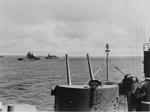 | 672k | Attu Invasion Force at anchor in Cold Harbor, Alaska. May 1943. There were 3 Battleships present for the Attu Operation: Idaho (BB-42), Pennsylvania (BB-38) and Nevada (BB-36), while for the Kiska operation the Nevada had been replaced by the Tennessee (BB-43).
The Nevada (moored next to Aux and 2 flush decker DD's) had her top reduced to a single cylindrical structure and carried her Mk 37 directors in tandem with the fore mount being centered atop the bridge and the after mount being much lower and located where the Main tripod mast had originally stood and that mast being much reduced in height was moved to just aft the funnel with fire control station still atop it. To prevent the fire control crew from being smoked out the funnel was extended to the level of the base of the fore fire control station. Also she did not receive her search radars until she got to Norfolk after Attu. Between the director and the funnel extension, a view from the angle of this photo would easily hide the tripod nature of the mast. Operating on the assumption that the picture was taken at Cold Bay in 1943 this is a portion of the Attu Invasion force and therefore the other BB must be the Idaho.
Now lets look at the ship in the foreground. There were only 4 ships assigned to the Attu Invasion equipped with closed dual mount 5"/38 shown; the 3 BB's and the Santa Fe (CL-60). We have accounted for 2 of these ships leaving only Pennsylvania and Santa Fe. The only other clearly define able object is the 40mm gun director tub to the right of the picture (under the weather shield). This appears to me to be the starboard side aft-most 5" gun mount on the Pennsylvania as the 40mm directors near the 5" turrets on the Santa Fe all seem to be mounted higher that the 5" gun not on the same level.
As this all started by looking at the Auxiliary, so lets go there next. Though the Navy made use of 8 or 9 commercial cargo ships for this operation, the ship in the photo seems to be caring a pennant number on her bow which makes her a Navy ship. The arrangement of the king posts, height of the funnel and the contour of the deck line convinces me that she is a Cimarron class Oiler (probably why she is sharing her berth with so many others (note the 2 flushdeckers on her port side). This would make her either the Platte (AO-24) or the Guadelupe (AO-32).
Carol listed the the ship at the far left and the far right as flushdecker DD's. The ship to the left is head(stern?)-on to the camera and can not be identified and the copy of the photo I received was blurred along the right and left edges making the left most ship indistinguishable; if it is a flush decker I can't tell but probably not. The DD's assigned to this operation were a mix of Farragut's, Porter's, Benson's and a single Gleaves class. Most of the active Flushdeckers serving as escorts were in the guarding merchant convoys across the back water's of the war or were converted to other uses. In the case of Attu there were a total of 6 assigned; not one of them as destroyers. Included were a High Speed Destroyer Transport, Kane (APD-18), a Destroyer Seaplane Tender, Williamson (AVD-2), 2 Destroyer Mine Layers, Sicard (DM-21) and Pruitt (DM-22) (assigned as landing craft control vessels) and 2 Destroyer Mine Sweepers, Chandler (DMS-9) and Long (DMS-12). Which of these are nested nest to the Oilier I can't say, not enough detail, but this at least cuts the the possibilities down a great deal.
There is another ship in the picture that is difficult to make out. It is a pale sillouette in the middle background and appears to be PG-51 Charleston. | Photograph courtesy of Ray Daves via Fabia Pena & Carol Edgemon Hipperson author of Radioman: An Eyewitness Account of Pearl Harbor & World War II in the Pacific (Thomas Dunne Books/St. Martins Press, 2008).
Photo i.d. & text courtesy of Chris Hoehn, Ron Reeves (of blessed memory) & Aryeh Weterhorn. |
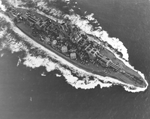
013644 |
640k |
A view from roughly 600 feet in altitude over the Caribbean Sea the day after departing the Panama Canal on her way to join the Atlantic Fleet, probably around 0930 on 14 July 1943, when Nevada (BB-36) reported a PBM patrolling around the formation of ships around Nevada . | Photo # 80-G-74412 now in the collection of the US National Archives in College Park, Maryland, courtesy of Tracy White @ researcheratlarge.com
|
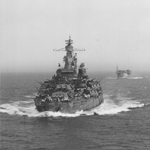
013642 |
839k |
Nevada (BB-36) after her modernization/repair after Pearl, was returning from Alaska, where she had provided fire support from 11 to 18 May 1943 for the capture of Attu. Operation Landcrab.
Photo shows then Nevada in company with escort carrier Croatan (CVE-25) astern on 14 July 1943 heading for Norfolk Navy Yard for further work, which would include a big new SK air-search radar on a lattice topmast. |
Terxt i.d. via Daniel Hacker.
Photo # 80-G-74411 now in the collection of the US National Archives in College Park, Maryland, courtesy of Tracy White @ researcheratlarge.com
|  | 120k | A line drawing by A.L. Raven of the Nevada (BB-36) in 1944, as rebuilt after Pearl Harbor, with twin 5in/38 guns. | Photo and text courtesy of U.S. Battleships: An Illustrated Design History by Norman Friedman. |
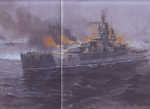 | 1.41k | An illustrated artwork by Howard Gerrard of the battleship Nevada (BB-36) opens fire with its main armament against the German defences on Utah Beach, dawn 6 June 1944. Nevada was part of Rear-Admiral Morton Deyo's bombardment Force A, located on the extreme right flank of the Allied invasion. | Image scanned from Operation Neptune 1944 by Ken Ford, Osprey Publishing, courtesy of Robert Hurst. |
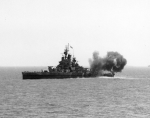 | 66k | Nevada (BB-36) bombards German positions ashore, while supporting the "Utah" Beach landings on 6 June 1944. | Official USN photo Naval History and Heritage Command # 80-G-231961, now in the collections of the National Archives. |
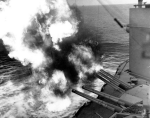 | 90k | Forward 14"/45 guns of Nevada (BB-36) fire on positions ashore, during the landings on "Utah" Beach, 6 June 1944. | Official USN photo Naval History and Heritage Command # 80-G-252412, now in the collections of the National Archives. |
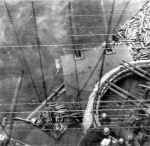 | 77k | At Normandy, 6 June 1944. In her role as a support gunfire ship, the view can be a a bit messy. A view looking down at a 5in/38cal gun and quad 40mm Bofors mount. The main deck is literally covered with spent shell casings. | USN photo. |
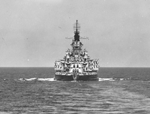 | 308k | Stern view of someone you would not want to meet in a dark alley. | National Archives # 80-G-256191 courtesy of David Buell. |
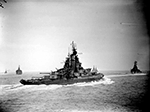 | 381k | With main guns trained to port, a starboard quarter view of the Nevada (BB-36) underway on 25 June 1944. The ship is moving into position off Cherbourg to bombard enemy gun batteries. | Source: Imperial War Museum Admiralty Official Collection by Allen, E.T. (Lt), Photo No. © IWM(A 24312) via Mike Green. |
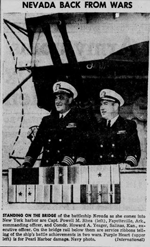 | NR | NEVADA (BB-36) BACK FROM WARS
STANDING ON THE BRIDGE of the battleship Nevada as she comes into New York harbor are Capt. Powell M. Rhea (left), Fayetteville, Ark., commanding officer, and Comdr. Howard A. Yeager, Salinas, Kan., executive officer. On the bridge rail below them are service ribbons telling of the ship's battle achievements in two wars. Purple Heart (upper left) is for Pearl Harbor damage. Navy photo. | Image and text provided by University of North Carolina at Chapel Hill Library, Chapel Hill, NC.
Photo from The Wilmington Morning Star. (Wilmington, N.C.) 1909-1990, 19 September 1944, FINAL EDITION, Image 2, courtesy of chroniclingamerica.loc.gov.
| 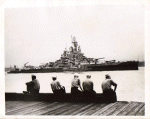 | 72k | The photo captions from ACME Newspictures, Inc. of New York City, dated 15 September 1944 reads:
"VETERAN OF TWO WARS RETURNS TO NEW YORK, NEW YORK: A group of sailors survey the Nevada (BB-36), as she comes up the Hudson River. The first battleship to return from this summer's Normandy Invasion 6 June 1944. The 32,000-ton battleship, a veteran of World War I, served in the Attu Campaign, in the Pacific before being sent to the Atlantic. And she was at Pearl Harbor during the Jap Attack, being the only battleship to get underway."
Her gun barrels were relined at New York, and she sailed for the Pacific, arriving off Iwo Jima 16 February 1945 to give marines invading and fighting ashore her massive gunfire support through 7 March.
Note: This photo was censored before being released. Her SK-2 radar on the foretopmast has been obscured.
| Partial text courtesy of DANFS.
Official USN photo courtesy of Robert M. Ceiri. |
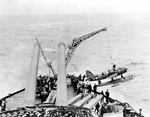 | 1.43k | OS2U Kingfisher being hoisted aboard the Nevada (BB-36) circa 1944-1945. | Source: National Museum of Naval Aviation, Photo No. NNAM.2004.166.002.004 via Mike Green.
| 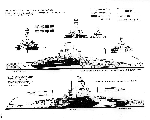 | 319k | Drawing prepared by the Bureau of Ships for Camouflage Measure 31a, Design 6B intended for the battleship Nevada (BB-36).
This plan, approved by Captain Torvald A. Solberg, USN, is dated 14 October 1944. It shows the ship's starboard side, exposed decks and other horizontal surfaces, and the ends of her superstructure, gun mounts and turrets. Nevada wore this pattern in late 1944 and the first months of 1945. | Text from USN photo # 19-N-73631, from the Bureau of Ships Collection in the U.S. National Archives.
Photo courtesy of Pieter Bakels.
|  | 83k | Drawing prepared by the Bureau of Ships for Camouflage Measure 31a, Design 6B intended for the battleship Nevada (BB-36).
This plan, approved by Captain Torvald A. Solberg, USN, is dated 14 October 1944. It shows the ship's port side, exposed decks and other horizontal surfaces, and the ends of her superstructure, gun mounts and turrets.
Nevada wore this pattern in late 1944 and the first months of 1945. | Official USN photo # 19-N-73630, from the Bureau of Ships Collection in the U.S. National Archives. |
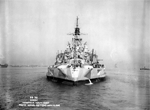 | 1.30k | Stern view of the Nevada (BB-36) off Norfolk Navy Yard on 8 November 1944. | Photo # 8877(44) courtesy of Ed Zajkowski. |
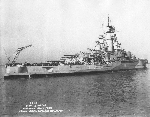 | 287k | Starboard quarter view of the Nevada (BB-36) off Norfolk Navy Yard on 8 November 1944. | USN photo courtesy of David Buell. Photo serial # 8876 (44.) |
 | 204k | Port broadside view of the Nevada (BB-36) off Norfolk Navy Yard on 8 November 1944. | USN photo courtesy of David Buell. Photo serial # 8875 (44.) |
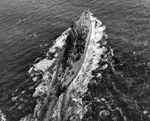 | 884k | Overhead view of Nevada (BB-36). | Photo # 80G-419697 from NARA, College Park, Maryland, courtesy of Sean Hert.
| 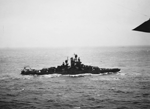 | 612k | Nevada (BB-36) broadside. | Photo # 80G-77069 from NARA, College Park, Maryland, courtesy of Sean Hert.
| 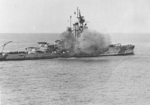 | 700k | Nevada (BB-36) bombarding Iwo Jima, 19 February 1945. A North Carolina class battleship (probably Washington BB-56) is in the left distance. | USN photo # N-3062A courtesy of David Buell & Insert photo # 80-G-K-3510 courtesy of Robert Hurst. |
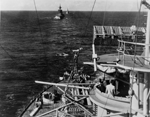 | 284k | At Ulithi, 27 January 1945 the Pensacola (CA-24) formed with a battleship-cruiser-destroyer gun strike task force under Rear Admiral B. J. Rodgers. Six battleships, four cruisers and a destroyer screen comprised the bombardment force which sailed 10 February via Tinian to Iwo Jima.
Pictured here are the Nevada (BB-36), West Virginia (BB-48) & Pensacola. | Text courtesy of DANFS.
USN photo # USN N-3173, courtesy of Scott Koen & ussnewyork.com.
| 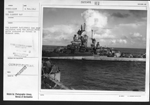 | 1.01k | Sargent Bay (CVE-83) has near collision with the Nevada (BB-36) while anchored at Ulithi in Bismark Archipelago, 6 February 1945. | USN photo # 80-G-321501 from National Archives and Records Administration (NARA), College Park, Maryland, courtesy of Sean Hert. |
 | 338k | Nevada (BB-36) taking Kingfisher and pilot on board after their day long patrol of Iwo Jima, 17 February 1945. | USN photo # 80-G-307154 from National Archives and Records Administration (NARA), College Park, Maryland, courtesy of Sean Hert. |
 | 71k | Nevada (BB-36) inboard profile, 1945. | Photo and text courtesy of U.S. Battleships: An Illustrated Design History by Norman Friedman. |
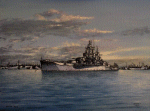 | 334k | The Nevada (BB-36) wearing the colors of the invasion forces in preparation for the invasion of Iwo Jima on 19 February 1945. | Painting courtesy of artbywayne.com & i.d. courtesy of Aryeh Wetherhorn.
| 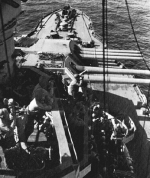 | 118k | Main guns ready and trained towards Iwo Jima, crew members watch the landing craft head towards shore during the initial landings. | USN photo. |
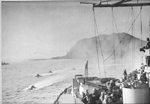 | 19k | LCI's heading for the beach on Iwo Jima, discharging their troops, taken by Nevada (BB-36). |
USN photo submitted by Pieter Bakels. |
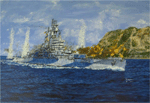 | 322k | The Nevada (BB-36) under fire while supporting UDT obstacle removal 2 days before the landings on Iwo Jima in February 1945. | Painting courtesy of artbywayne.com. |
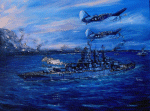 | 58k | A painting by the artist Wayne Scarpaci entitled "By Dawn's Early Light".
At dawn on the second day of the Iwo Jima operation depicts the Idaho (BB-42) bombarding Mt. Suribachi. The aircraft are SB2C's from VB 17 Yorktown (CV-10). In the background is the Nevada (BB-36). | Painting courtesy of artbywayne.com
| 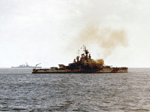 | 801k | Nevada (BB-36) bombarding Iwo Jima, 19 February 1945. A North Carolina class battleship, probably Washington (BB-56) is in the left distance.
Note: The ship in the background is the Washington, as this ship doesn't have the secondary conn that the North Carolina (BB-55) had added on the tower foremast.
| Official USN photo # 80-G-K-3510, now in the collections of the National Archives via Robert Hurst. Photo i.d. & partial text courtesy of Mike Green. |
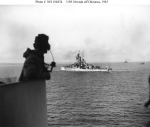 | 61k | Nevada (BB-36) operating off Okinawa, circa March-May 1945.
She is wearing Camouflage Measure 31a, Design 6B. | Official USN photo # NH 104834, from the Bureau of Ships Collection in the U.S. National Archives. |
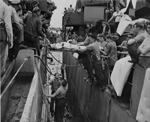 | 632k | Wounded men from the Nevada (BB-36) are transferred to an amphibious craft for further transfer to a Navy hospital ship. 11 men were killed, 41 wounded, when the big battleship was hit by a Jap suicide plane off Okinawa early in the morning of 27 March 1945. | Photo # 841581 152 BuAer 274508; 09-7930-11, U.S. Navy BUMED Library and Archives, courtesy of Bill Gonyo. |
 | 999k | Nevada (BB-36) being crashed by a Acchi 99 Val Kamikaze on 27th of March 1945 off Okinawa. | Painting courtesy of artbywayne.com. |
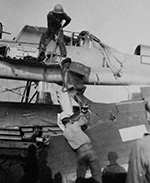 | 142k | Damages sustained by Nevada (BB-36), as a result of a Japanese suicide plane attack off Okinawa, Ryukyu Islands. Photographed by PHOM2/C J.G. Mull, 27 March 1945. | USN photo # 80-G-274498 from the National Museum of the U.S. Navy via flickr.com. |
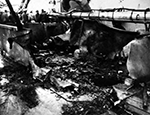 | 142k | Damage to ship's structure and deck off Okinawa, Ryukyu Islands. Photographed by PHOM2/C J.G. Mull, 27 March 1945. | USN photo # 80-G-274492 from the National Museum of the U.S. Navy via flickr.com. |
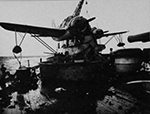 | 112k | Damage sustained off Okinawa, Ryukyu Islands. Photographed by PHOM2/C J.G. Mull, 27 March 1945. | USN photo # 80-G-274481 from the National Museum of the U.S. Navy via flickr.com. |
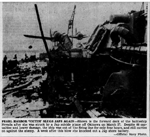
013603m | NR | PEARL HARBOR ‘VICTIM' SLUGS JAPS AGAIN
Shown is the forward deck of the battleship Nevada (BB-36) after she was struck by a Jap suicide plane off Okinawa on 27 March. Despite 60 casualties and heavy damage, the ship was out of the firing line for only four hours, and still carries on against the enemy. A week after this blow she knocked out a Jap shore battery. | Official Navy Photo.
Image and text provided by Library of Congress, Washington, DC.
Photo from Evening Star. [volume] (Washington, D.C.) 1854-1972, 18 July 1945, Image 4, courtesy of chroniclingamerica.loc.gov.
|  | 22k | Damage from a kamikaze attack on the Nevada (BB-36), 27 March 1945 off Okinawa. | Photo from WII War Damage Reports, courtesy of NavSea / dcfp.navy.mil. |
 | 30k | Damage from a Japanese shore battery 5 April 1945 off the coast of Okinawa, | Photo from WWII Damage Reports, courtesy of NavSea / dcfp.navy.mil. |
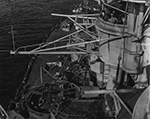 | 246k | Nevada's (BB-36) starboard side as seen from her forward tripod between 7 and 19 April 1945. She was supporting the invasion of Okinawa at this time.
| USN photo # 80-G-317397 now in the collection of the US National Archives in College Park, Maryland, courtesy of Tracy White @ researcheratlarge.com
| 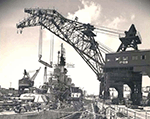 | 775k | Nevada (BB-36) in drydock May 1945 at Pearl Harbor Naval Ship Yard. Having repairs to the damage caused by the kamikaze attack at Okinawa. Turret number three is being regunned also. | Photo courtesy of Joe MacDonald. |
 | NR | How a Dead War Fleet Came Back to Fight
On the morning of 7 December 1941, the Nevada (BB-36) lay quietly with other powerful ships of Uncle Sam's fleet along side a quay at Pearl Harbor when the Japanese unleashed their sneak blow. The Nevada was badly damaged. Slowly, she was restored to fighting trim. Since then she has participated in many battle actions. Here is a view of the Nevada taken in 1944. | Image and text provided by Library of Congress, Washington, DC.
Photo & text by Evening Star. [volume] (Washington, D.C.) 1854-1972, 17 June 1945, Image 36courtesy of chroniclingamerica.loc.gov.
|
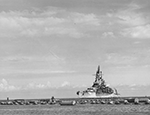 |
337k |
Nevada (BB-36) at anchor, circa June 1945. |
USN photo # 80-G-323801, from NARA, College Park, Maryland, courtesy of Sean Hert.
|  | 82k | Pearl Harbor Veterans, the Tennessee (BB-43), California (BB-44) and Nevada (BB-36) steam out of Buckner Bay, Okinawa on 17 July 1945. All had been sunk or damaged during the attack on Pearl Harbor. | USN photo. |
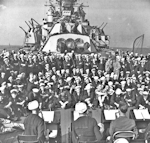 | 163k | A little day music (not to be confused with Mozart) for the Nevada's (BB-36) crew. | USN photo courtesy of David Buell.
| 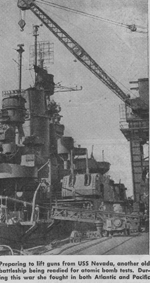 | 772k | Nevada (BB-36) photo from 1946 edition of Popular Mechanics. | USN photo courtesy of David Buell. |
 | 657k | The Nevada (BB-36) on the morning of the 14th of August 1945, which was VJ Day, the day the fighting stopped. Nevada fought from the first day of WWII to the last and earned seven battlestars in the process. She steamed 137,027.34 miles, spent 389 days in combat zones, fired 5,028 14" rounds 18,297 5" rounds, 23,333 40mm rounds, 13,311 20mm rounds. She destroyed 5 Japanese, and 3 German planes, countless guns, tanks, bridges, supply dumps, fuel dumps, and ammunition dumps. She also neutralized an enemy battlecruiser, and 6-15" gun emplacements. | Painting courtesy of artbywayne.com.
| Post War - Sinking
|
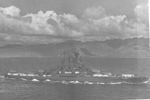 | 213k | Nevada (BB-36) after wars end in 1945. | USN photo courtesy of David Buell. |
 | 192k | Crew picture of the Nevada (BB-36), 28 October 1945 at Pearl Harbor. | USN photo courtesy of Gary Saxon. |
 | 233k | 'Bravo Zulu Nevada'
Bravo Zulu is the flag hoist for 'Well Done'. Here is Nevada (BB-36) participating in a joyous occasion, rare in war, returning victorious after WWII. The ship has just passed Angels Gate light and taken on a pilot, tugs are waiting to assist her to her berth at the Long Beach Navy Yard. Nevada is flying a signal hoist of her radio call sign NADK and the 'Roger' 'R' flag indicating she is ready for duty. I am sure the sailors are all thinking 'Thank God we made it' and of the liberty that awaits them tonight. (Watch out San Pedro). From her foremast Nevada is flying her 'Homeward Bound Pennant', it is 389 feet long, with each foot representing one day in a combat zone and it is adorned with the seven battle stars which she was awarded during the war. Nevada returns proudly with a war record of downing five Japanese and three German planes. During the war she fired 5,028 14" rounds, 18,297 5" rounds, 23,311 40mm rounds and 11,333 20mm rounds. She steamed 137,027.34 miles. Her crew won 2 Medals of Honor, 15 Navy Crosses, 2 Silver Stars, 10 Bronze Stars, 240 Purple Hearts, 1 Air Medal and 3 Navy and Marine medals. She was hit by a torpedo, 7 bombs, 1 kamikaze, and 5 4.7" shells. | Painting courtesy of artbywayne.com. |
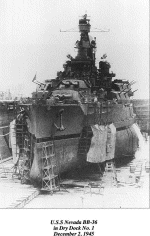 | 182k | Bow on view of the Nevada (BB-36) in Dry Dock # 1, on 2 December 1945. | USN photo courtesy of Richard Miller, BMCS, USNR RET. |
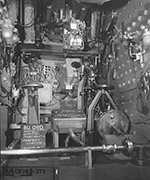 | 160k | The Nevada (BB-36) pointer's station #3, photographed at Operation Crossroads, 17 May 1946. | USN photo # 74-BO-A6 BB-36 02 courtesy of Tracy White @ Researcher @ Large. |
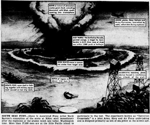 | NR | SOUTH SEAS FURY—Above is © Associated Press Press Artist Hank Barrow's conception of the scene at Bikini atoll immediately after the explosion of the atomic bomb late today, Washington time. More than 37,000 men are at the little Pacific island to participate in the test. The experiment known as "Operation Crossroads," is a joint Army, Navy and Air Force undertaking and is designed primarily as test of sea power in the atomic age. | Image and text provided by Library of Congress, Washington, DC.
Photo from Evening Star. [volume] (Washington, D.C.) 1854-1972, 30 June 1946, Image 8, courtesy of chroniclingamerica.loc.gov.
| 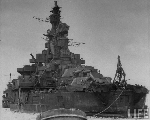 | 113k | Stern view of the Nevada (BB-36) taken 8 July 1946. | Photographer: Bob Landry, courtesy of life.com.
| 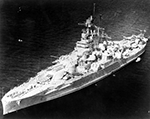 | 654k | Ex-Nevada (BB-36) anchored after being prepared to take part in the bikini atom bomb tests. She was painted orange-red for these tests, as she was designated as the target vessel.
| Source: United States National Archives, Photo No. 80-G-702620 courtesy of Mike Green. |

013436c | 1.43k | Project 18 - Operation Crossroads (Bikini) Test Activities: Nevada (BB-36) colored orange with New York (BB-34) & other major vessels listed in the table at the bottom of the photo. | Record Hierarchy
Record Group 374:
Records of the Defense Threat Reduction Agency, 1943 - 2005 Series: Photographs of Atmospheric Nuclear Testing at Pacific Island and Nevada Test Sites, 1946 - 1962. Project 18 - Operation Crossroads (Bikini) Test Activities
National Archives Identifier: 146763102.
Local Identifier: 374-ANT-18-CR-553-14.
Photo courtesy of catalog.archives.gov, via Yu Chu. |
 | 121k | Operation Crossroads, Joint Task Force One, Bikini Atoll Able Day "Plus 1". The orange warship is Nevada (BB-36). | USN photo courtesy of Brian Kroenung. |
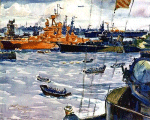 | 52k | "Evacuation of the Fleet" by Arthur Beaumont. Selected as ground zero for test ABLE, Nevada (BB-36) was painted bright orange to assist the B-29 bomber crew find their aim point. Although the old battleship survived both bombs, extensive contamination from test 'Baker' led to her destruction by gunfire and aerial torpedoes in an exercise off Hawaii on 31 July 1948. The view is from the bridge of Arkansas (BB-33), during final test preparations and the evacuation of people and the support fleet from Bikini lagoon. | #1 Watercolor, 1946. Gift of the artist.
NHC # 88-169-A, from the collections of the Naval Historical Center. |
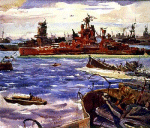 | 55k | Operation Crossroads, Joint Task Force One, Bikini Atoll Able Day "Plus 1" by Grant Powers. Panoramic view of the fleet after test ABLE sketched from the bridge of Arkansas (BB-33). The ship in the middle is the scorched Nevada (BB-36), with Nagato behind and Sakawa sinking in the foreground. | #2 Watercolor, 1946. Gift of the artist.
NHC # 88-169-B, from the collections of the Naval Historical Center. |
 | 904k | 'Countdown to Burst, 5...4...3...2...'.
This is the undoubtedly the most unique painting I have ever done of a battleship. It is of the Nevada (BB-36) when she was painted bright orange to be used as the aiming point for the 'Shot Able' atomic bomb test at Bikini in July 1946. (But the Air Force, in spite of making 3 runs on the target, still missed by almost 1,000 yards). If you notice above the bow you can see the bomb (Mk3 'Fat Man' Plutonium Implosion type device 21KT yield) suspended on a parachute. The B29 that dropped the bomb it to the right and at top speed to get away from the blast. You will also notice more monitoring planes, (which were all remote controlled drones) in the sky. In the post shot able survey, Nevada was deemed to be still operational and only lightly radioactive. That all change after the underwater 'Shot Baker' which lifted millions of gallons of water and pulverized coral and deposited it all over the Nevada and all the other ships. Nevada was now dangerously radioactive, (but otherwise considered still operational). She was stored at Kwajalein until sunk as a gunnery target off Hawaii in 1948.
The painting is another in the series I am doing to commemorate the 100th anniversary of the launching of the Nevada. | Painting courtesy of artbywayne.com. |
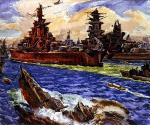 | 55k | "Japanese Cruiser Sakawa Sinking" by Arthur Beaumont, #3 Watercolor, 1946. The former Japanese cruiser Sakawa sank in frothy green waters the day after test ABLE. Damaged battleships Nevada (BB-36) and Nagato are in the background. | # 3 Watercolor, 1946. Gift of the artist.
NHC # 88-169-C, from the collections of the Naval Historical Center.
Nagato insert painting courtesy of artbywayne.com.
|  | 44k | Operation Crossroads, Joint Task Force One, Bikini Atoll Able Day "Plus 2 Seconds" by Grant Powers. The fireball surrounded by bomb debris and water vapor begins to rise into the sky. At the same time, the blast wave moves out from the bottom at 180 mph. The orange warship on the left is Nevada (BB-36). | #9 Watercolor, 1946. Gift of the artist.
NHC # 88-181-I, from the collections of the Naval Historical Center. |
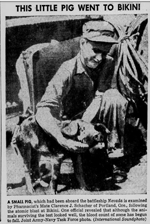 |
NR |
THIS LITTLE PIG WENT TO BIKINI
A SMALL PIG, which had been aboard the battleship Nevada (BB-36) is examined
by Pharmacist's Mate Clarence J. Schacher of Portland, Ore., following the atomic blast at Bikini. One official revealed that although the animals surviving the test looked well, the blood count of some has begun to fall. |
Joint Army-Navy Task Force photo. International Sound photo
Image and text provided by University of North Carolina at Chapel Hill Library, Chapel Hill, NC.
Photo from The Wilmington Morning Star. (Wilmington, N.C.) 1909-1990, 08 July 1946, Image 3, courtesy of chroniclingamerica.loc.gov.
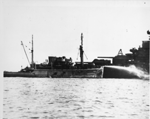
013605 | 388k | Project 18 - Operation Crossroads (Bikini) Test Activities - Nevada (BB-36) being sprayed down after the blast, 1946. | National Archives Identifier:45512554
Local Identifier: 374-ANT-18-1.
Photo courtesy of catalog.archives.gov
| 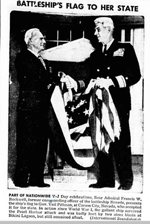
013645b | NR | BATTLESHIP'S FLAG TO HER STATE
PART OF NATIONWIDE V-J Day celebrations, Rear Admiral Francis W.Rockwell, former commanding officer of the battleship Nevada (BB-36), presents the ship's battle flag to Gov. Vail Pittman at Carson City, Nevada, who accepted it for the state.....
| Insert photo courtesy of: Nevada State Museum via Yu Chu
Image and text provided by University of North Carolina at Chapel Hill Library, Chapel Hill, NC.
Photo from Henderson Daily Dispatch. (Henderson, N.C.) 1914-1995, 21 August 1946, Image 1, courtesy of chroniclingamerica.loc.gov.
|
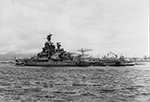 |
423k |
Nevada (BB-36) in Pearl Harbor, 26 June 1947, after the Bikini atomic bomb tests. |
Photo courtesy of Wayne Scarpaci via David Buell.
| 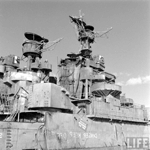 | 186k | Backwards "Danger Keep Off" signs adorn the sides of the Nevada (BB-36) at Pearl Harbor, January 1948.
| Photographer: Elliot Elisofon, courtesy of life.com.
Photo i.d. courtesy of Chris Hoehn & Mike Green. |
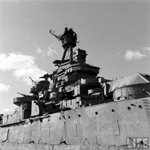 | 162k | Amidships view of the Nevada (BB-36) as a wreck waiting to be sunk at Pearl Harbor, January 1948.
| Photographer: Elliot Elisofon, courtesy of life.com.
Photo i.d. courtesy of Chris Hoehn & Mike Green. |
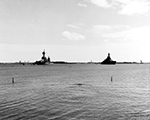 | 489k | Ex- New York (BB-34) and Ex-Nevada (BB-36) anchored at Pearl Harbor on 8 June 1948. Both had served as targets in the Bikini atomic bomb tests two years previously, and will be sunk in ordnance tests a few weeks after the photo was taken.
| Source: United States National Archives, Photo No. 80-G-498043 courtesy of Mike Green.
| 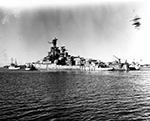 | 719k | Ex-Nevada (BB-36) being towed out of Pearl Harbor, on 26 July 1948, to be sunk as target. Towing ship is Jicarilla (ATF-104). Note damage sustained by the Nevada in the Bikini Atomic bomb tests two years previously.
| Source: United States National Archives, Photo No. 80-G-396330 courtesy of Mike Green. |
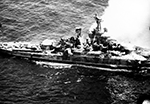 | 697k | Ex-Nevada (BB-36) being used as a target vessel off Hawaii on 31 July 1948. Note severe damage forward and Army tanks on stern. | Source: United States National Archives, Photo No. 80-G-498259 courtesy of Mike Green. |
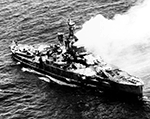 | 630k | Ex-Nevada (BB-36) on fire and being sunk in ordnance tests off Pearl Harbor on 31 July 1948. | Source: United States National Archives, Photo No. 80-G-498257 courtesy of Mike Green. |
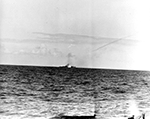 | 594k | Ex-Nevada (BB-36) hit by naval gunfire while serving as a target vessel off Hawaii on 31 July 1948.
| Source: United States National Archives, Photo No. 80-G-498258 courtesy of Mike Green. |
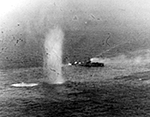 | 559k | Ex-Nevada (BB-36) hit by naval gunfire while serving as a target vessel off Hawaii on 31 July 1948.
| Source: United States National Archives, Photo No. 80-G-396404 courtesy of Mike Green. |
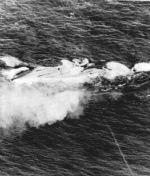 | 75k | 31 July 1948 photo of the Nevada (BB-36) succumbing to naval gunfire and aerial torpedoes off Hawaii. | USN photo. |
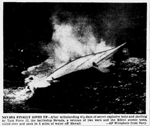 | NR | NEVADA (BB-36) FINALLY GIVES UP—After withstanding 4 1/2 days of secret explosive tests and shelling by Task Force 12, the battleship Nevada (BB-36), a veteran of two wars and the Bikini atomic tests, rolled over and sank in 5 miles of water off Hawaii. | Insert PDF image and text provided by Library of Congress, Washington, DC.
Other PDF by University of North Carolina at Chapel Hill Library, Chapel Hill, NC.
Insert PDF courtesy of Evening Star. [volume] (Washington, D.C.) 1854-1972, 31 July 1948, Image 2.
Photo from The Wilmington Morning Star. (Wilmington, N.C.) 1909-1990, 2 August 1948, FINAL EDITION, Image 3, courtesy of chroniclingamerica.loc.gov.
| 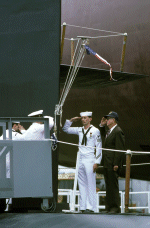 | 397k | A former crew member of the World War II Nevada (BB-36), right, and a crew member of the nuclear-powered strategic missile submarine Nevada (SSBN-733), salute after raising the ship's commissioning pennant at Groton CT., 16 August 1986. | USN photo # DN-ST-87-00382, by PHAN K.P. Keller, from the Department of Defense Still Media Collection, courtesy of dodmedia.osd.mil. |
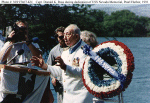 | 1.43k | Captain Donald K. Ross during dedication of Nevada Memorial, Pearl Harbor, 1991. | Naval History and Heritage Command # NH 97467-KN, from the collections of the Naval Historical Center. |
 | 698k | Medal of Honor winner Captain Donald K. Ross, USN (ret.), who was engineering officer aboard the Nevada (BB-36) on the day of the attack on Pearl Harbor, and Captain Joseph K. Taussig Jr., USN (ret.), who was awarded the Navy Cross for heroism, reminisce during Survivor's Day ceremonies, 5 December 1991. The event honors the sailors and Marines of the battleships that were sunk or damaged in the 7 December 1941, bombing.
| USN photo # DN-SC-92-05807, by JOC(AW) Gloria Montgomery, from the Department of Defense Still Media Collection, courtesy of dodmedia.osd.mil. |
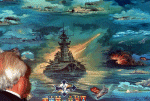 | 376k | A guest studies a painting depicting the history of battleships. The artwork was painted by George Skybeck and presented to the Pearl Harbor Survivors Association during their annual banquet at Honolulu, Hawaii, on 8 December 1991.
| USN photo # DN-SC-92-05391, by PHC Carolyn Harris, from the Department of Defense Still Media Collection, courtesy of dodmedia.osd.mil. |
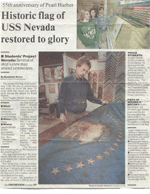 | 1.51k | 1996 article on restoration of Nevada's (BB-36) flag. | Photo from the Author's collection.
| 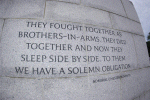 | 371k | A quote made by Fleet Adm. Chester W. Nimitz is inscribed on a granite wall at the National World War II Memorial located on the National Mall in Washington, D.C. Fleet Adm. Nimitz was the United States signatory to the surrender terms aboard the battleship Missouri (BB-63) in Tokyo Bay, Japan on 2 September 1945, thus ending World War II. Established by the American Battle Monuments Commission, the memorial honors all military veterans of World War II, the citizens on the home front, the nation at large, and the high moral purpose and idealism that motivated the nation's call to arms. On 29 May 2004, the memorial was formally dedicated with an estimated 200,000 people expected to attend, and includes 100,000 visiting veterans of all wars. | USN photo # N-0295M-011 by Photographer's Mate 2nd Class Daniel J. McLain, courtesy of news.navy.mil. |
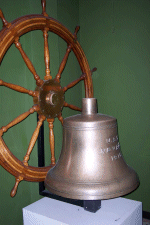 | 156k | The bell & ship's wheel of the battleship Nevada (BB-36), located in the Nevada State Museum, Carson City, Nevada, 24 August 2004. | Photo copyright courtesy of Hugh Hudson.
|
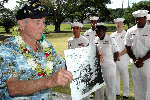 | 339k | Pearl Harbor survivor Woody Derby, stationed aboard the battleship Nevada (BB-36) during the 7 December 1941 attack, recounts his experiences to Sailors during a historic photograph presentation at Nevada Hall Bachelors Enlisted Quarters on board Naval Station Pearl Harbor, 13 December 2005. | USN photo # N-3019M-001 by Journalist 2nd Class Ryan C. McGinley, courtesy of news.navy.mil. |
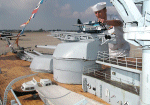 | 306k | Engineman 1st Class Ronnie Choate adjusts a model of OS2U Kingfisher seaplane aboard a large-scale model of the battleship Nevada (BB-36), at the annual Wings, Wheels, Rotors and Expo held at the Los Alamitos Joint Forces Training Base, 24 October 2004. Choate works with Navy Recruiting Command at Seal Beach Naval Weapons Stations, Calif., helping bring the model of the World War II era battleship to various events in Southern California. The model was originally used in the filming of the 1970 motion picture "Tora! Tora! Tora!" which depicted the 7 December 1941, Japanese attack on Pearl Harbor. | USN photo # N-1159B-007 by Journalist 2nd Class Brian Brannon, courtesy of news.navy.mil. |
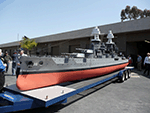 | 2.04k | 4 photo PDF of the battleship Nevada (BB-36) model filmed in the movie Tora,Tora,Tora
The model is 1/15th scale size at 38ft long,7ft wide and 13ft and is maintaned under the custodianship of The Quarter Deck Society (retired Navy and Navy veterans). The model is shown in our local Armed Forces Day Parades and static displays with Coast Guard,Navy,Sea Cadets and Army in Torrance Calif. The model is also transported on it's triple-axle trailer to Navy Days L.A. in San Pedro,Calif and displayed dock side next to active duty Naval vessels in port during open public displays. Please contact Ernie Kost at 661-252-9537 for more info. | Photos courtesy of The Quarter Deck Society. |

013669s | 875k | Nevada (BB-36) mooring quay taken on 11 April 2019.
| Photo by M. Gurnas courtesy of Yu Chu.
| 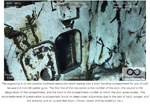
013646f | 979k | The engraving is on the exterior bulkhead above the hatch leading into a shell handling compartment for one of Nevada's (BB-36)
5-inch/38 caliber guns. The first line of the inscription is the number of the door, the second is the designation of the compartment, and the third is the compartment number to which the door gives access. This remarkable level of preservation is occasionally found on deep-ocean shipwrecks due to the lack of light, oxygen, and the extreme cold at 15,400 feet down. | Photo: Ocean Infinity/SEARCH, Inc. courtesy of Yu Chu.
| | | | | | | |